-
Content count
35,689 -
Joined
-
Last visited
-
Days Won
55
Posts posted by Cube
-
-

The Living Daylights: The Computer Game
- Original Release: 1987
- Developer: Sculptured Software, Walking Circles Software De Re Software, Exasoft
- Publisher: Domark
- Platform: Commodore 64, Amiga, ZX Spectrum, Amstrad CPC, Amstrad PCW, MSX, Atari, BBC Micro, Arcade (possibly)
- Version played: Commodore 64

The second Domark game for James Bond, this time based on The Living Daylights. This one has a single consistent gameplay style throughout the whole game. It’s a run-and-gun shooter, but with a control method that is an interesting idea but doesn’t quite work.
Shooting works a lot like a lightgun game – place your cursor over the enemy and fire to kill them. However, the game doesn’t scroll automatically, you have to move Bond yourself. To do this, you move the cursor to the right side of the screen and carry on holding right. You can also jump by pressing up while still moving right – something that took me a few levels to figure out, as Bond just kept falling over obstacles every now and then.
If the cursor was fast and more precise, this might work, but as you’re moving, enemies can pop up on the left side, meaning that it takes a while to move the cursor over to them.
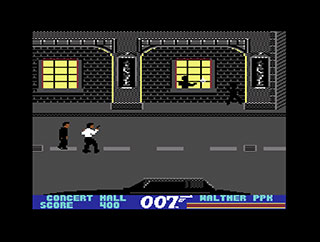
After you finish a level, you can choose a special weapon for the next level. The weapons changes the strength of your shot, but don’t alter any graphics, so Bond’s “Bazooka” kills enemies in one shot, but Bond is still holding a pistol. One option at the end of the first level is an Infrared Sight. If you don’t choose this, all the enemies will be shadows, and this is the only level with civilians – shoot them and you’ll lose points. If the Bazooka is available, definitely choose that for other levels.

While the first few levels are incredibly grey, there’s a bit of colour late on. The graphics make use of the Commodore 64 quite well, with some nice locations. You’ll encounter a few different enemies. Most are at the “back”, but a few will stand in your way and throw bombs at you (the first of these throws explosive milk bottles). The game also has some nice music to go with it.
The Living Daylights is a decent game, hampered by the awkward controls. It doesn’t really do anything special, but it also isn’t horrible in any way.
Other Versions
Amstrad CPC
This version has simpler and flatter looking graphics, although some of the stages are much more colourful in this area, especially the first stage, which is just grey in the C64 version.

Amstrad PCW
This is similar to the Amstrad CPC version, except that it runs in monochrome.

Atari 8-Bit Systems
This version has simpler graphics, but tried to create the depth of the full version, instead of simplifying the layout like the Amstrad version. This makes this version look cluttered and messy.

ZX Spectrum
The graphics for this version are simple, but they have been properly adapted to suit the system.

BBC Micro
The graphics for this version are simple, but they have been properly adapted to suit the system. One issue the game has is that the obstacles don’t always load properly, so Bond will often trip over nothing.

Amiga, Atari ST and Arcade
It’s quite difficult to find information in these versions, and my conclusion is that it seems they were never released. A developer Richard Naylor was working on the arcade version for Arcadia Systems, which was essentially an arcade cabinet using an Amiga.
---

Live and Let Die: The Computer Game
- Original Release: 1988
- Developer: Keypunch, Elite
- Publisher: Domark
- Platform: Commodore Amiga, Atari ST, Commodore 64, Amstrad CPC, ZX Spectrum
- Version played: Commodore Amiga
- Also Known As: Aquablast

This game was in development before there were any plans to make a Live and Let Die game. Publishers Domark saw Aquablast under development. Aquablast was a speedboat action game and, because there’s a speedboat sequence in Live and Let Die, decided to help publish it as a Bond game – although only in the UK, it was still released as Aquablast in the USA.
Live and Let Die has you operating a speedboat equipped with a gun and missiles. The gun is simple enough to use, but the missiles can only be fired if you go fast enough first then fire when slowing down. These need to be saved for certain targets, but you can collect more (as well as fuel) from crates dropped by helicopters.

As you play, you’ll weave through enemies and dodge obstacles, and there’s a decent amount of both, including narrow areas with walls, planes dropping torpedoes and slides you have to use to dodge rocks. The game consists of four missions.
The first is a training mission with infinite fuel and missiles. Here you have to destroy red targets with your gun and black targets with your missiles. Then there are North Pole and Sahara levels, where you can practice using limited missiles and fuel. The levels have a different look but all feel exactly the game.
The final mission is New Orleans, once you hit a certain number of points, you need to destroy Mr. Big’s base by firing a missile from mid-air (you do this by hitting a log).

The gameplay is fun but, due to the game never changing, wears off very quickly. This is fine for a quick blast but it’s also obvious that this was never designed to be a Bond game. If Domark had waited another year, they could have used a much better speedboart combat game called Cobra Triangle.
Other Version
Atari ST
The Atari ST version is identical to the Amiga version.
Commodore 64
This version is the nicest looking 8-bit version, the 8-bit versions do run a bit slower compared to the main versions.

Amstrad CPC
This one has more cluttered backgrounds that doesn’t look quite as nice as the Commodore 64 version.

ZX Spectrum
The ZX Spectrum struggles to run this game, even with the graphics toned down a lot.

---

007: Licence to Kill
- Original Release: 1989
- Developer: Quixel
- Publisher: Domark
- Platform: Commodore Amiga, Atari ST, MS-DOS Commodore 64, Amstrad CPC, ZX Spectrum, MSX, BBC Micro
- Version played: Commodore Amiga

Coming from developers Quixel, Licence to Kill is a vertical scrolling shooter depicting events from Licence to Kill. The game is comprised of 5 very short, but difficult, missions, with some fun gameplay. While the style of the game remained the same throughout, the gameplay itself varies through each level.

The first mission has you chasing a jeep in a helicopter. If you fly fast, the helicopter will get lower, allowing you to attack the jeep. The objective is to get to the end of the level, but destroying the jeep will help with the start of the second level.

Next up is an on foot section, which is the longest level of the game (around 3-4 minutes). If you hold the fire button, you can adjust your aim to shoot diagonal or sideways. There’s no automatic scrolling in this one, so you can kill enemies at your own pace.

Next you take to the skies as you dangle from a helicopter, there’s no enemies here, you just need to stay on top of the plane long enough for Bond to lock on to it.

In the water, Bond has no weapons, but can punch divers carrying harpoons to attack other enemies. You can also dive underwater to dodge enemy fire. You need to latch on to the water plane to get back in the sky.

In the final mission, you start off in a plane before jumping onto a truck. You then have to destroy all the other trucks to stop Sanchez and defeat the game.
The game is good fun, but once you figure out what to do in each level, it’s incredibly short – around 12 minutes if you don’t rush.
Other versions
MS-DOS
This version has the nicest graphics, but I found it to be buggy, with sprites flickering out of existence and some hits not detected, which is why I ended up playing the Amiga version.
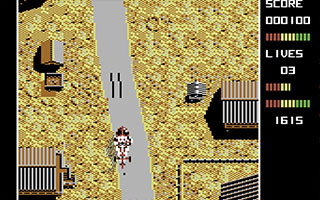
Atari ST
This version is identical to the Amiga version
Commodore 64
Heading to the 8 bit versions, the C64 version attempts to keep the detailed backgrounds, making it hard to see what is happening on screen due to how busy it is.

Amstrad CPC
While the graphics are toned down from the Commodore 64, the simpler style makes it look nicer.

ZX Spectrum
Things get even more basic, this version has a lot of outlines instead of coloured sprites.

MSX
The MSX version is similar to the ZX Spectrum, but the colours are more muted.

BBC Micro
This version is again based on the ZX Spectrum version, but the game only displays two colours at a time, including the menu.

NES (Cancelled)
A version of this game was in development for the NES by Tengen. While the final level hadn’t been made, Domark considered the game finished, but decided to not publish the game as it was too long after the other versions
Sega Master System (Possibly)
A few places online state that a Master System version of this released in South Kora in 1996, but I can’t find any concrete details or imagery.
---

James Bond 007 The Game (Descartes)
- Original Release: 1989
- Developer: I. Loffre, F. G. Ricard
- Publisher: Descartes Editeur
- Platform: Board Game
- Original Name: James Bond 007 Le Jeu
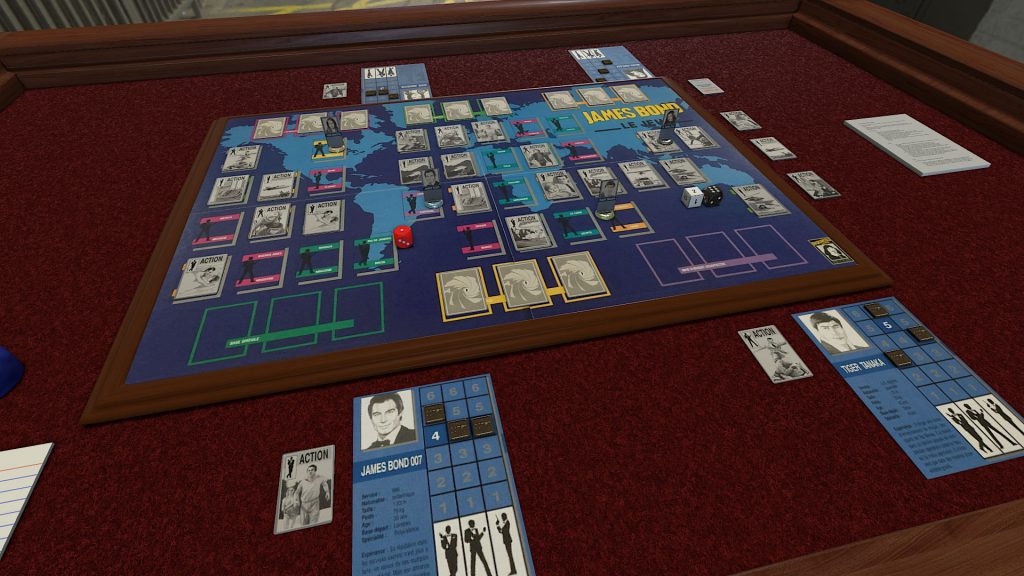
A French board game from Descartes Editeur, featuring artwork of Timothy Dalton. I should point out that, due to limited sources, I’m not sure entirely how accurate my Tabletop Simulator version is, but the main mechanics are from a description of the game so that part is at least correct.
The goal of the game is to defeat all the villains of on the board – the player who has defeated the most when the last villain is defeated wins. Players will take turns trying to complete action cards by using their skills of gunfight, brawling and seduction/charm. You roll a dice and add the level of the matching skill, trying to score 8 or higher to collect a card.

These cards can either be gadgets, which let you improve a dice roll, or an information card, which lets you fight a villain. The villain fights work in a similar way, except you don’t know up front what skill will be in use. You can also choose to attack another player. If you win, they lose a skill level and you get to steal 0-3 cards (determined by dice roll).
Unless there are some in depth rules I’m not aware of, this game is just a long, drawn out slog. The mechanics are very simple and it’s just rolling a dice to see if you win.
---
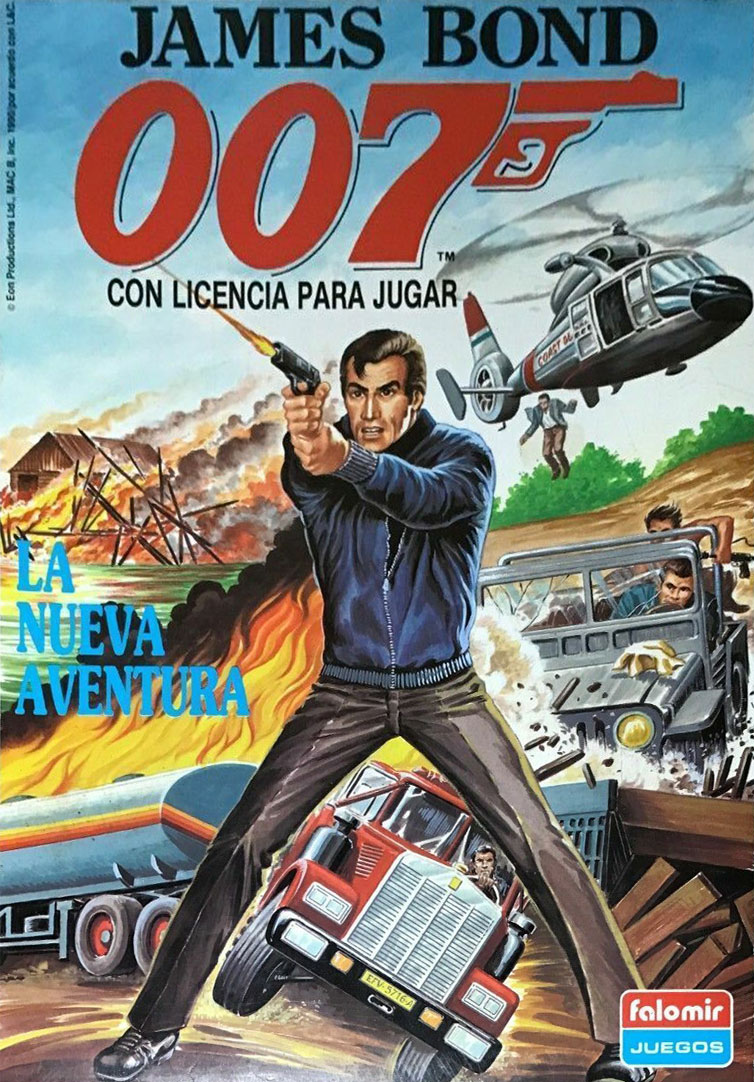
James Bond 007: A New Adventure
- Original Release: 1989
- Developer: Falomir Juegos
- Publisher: Falomir Juegos
- Platform: Board Game
- Original Name: James Bond 007: La Nueva Aventura

This is a Spanish board game from Falomir Juegos. In this, you have to make it through six missions, disarming or avoiding traps set by other players.
Each side of the board has three missions. At the start of the game, you’ll take turns placing your trap tiles. Three of these are just explosions while a fourth has 50 points on it (but is still an exploding trap).
You’ll take turns rolling a dice and moving up to that many spaces. You can move in any direction, but you must stick to that direction for your entire move. Players can’t share spaces, but can move past them if you have enough movement left.

If you move onto a trap, you’ll roll a dice. If you get a 1, you have disarmed it and will discard it (if it’s 50 points, the person the trap belongs to gives you 50 points). If you fail, the trap’s owner will roll and if they get a 5 pr 6, the trap explodes. If it’s a 50 points card, you will have to give the owner 50 points. If it’s an explosion, you’ll lose one of your six life cards.
Traps can also go off if players are in line with them – you spin the compass and if it matches the direction, it will explode.
The first player that makes it past mission 3 will get points from all other players based on what mission they’re currently on, then the board is flipped and you to the entire game again.
This is an incredibly tedious and drawn out board game. Getting to mission three is annoying enough, and that’s just the half way point. There’s nothing fun about the game, it’s all just dice rolls.
-
.png) 1
1
-
)
007 James Bond: Goldfinger (Victory Games)
- Original Release: 1985
- Developer: G. Christopher King
- Publisher: Victory Games
- Platform: Board Game

Alongside the big RPG and it’s many additions, Victory Games also made a series of simpler board games, each loosely based on an event from one of the films. This one portrays the car chase from Goldfinger. In this game, the Bond player must find Tilly and escape, while the enemy player must delay or destroy Bond’s car.
The enemy player has five cards: Tilly, three traps and a blank card. These are placed on buildings face-down for Bond to search. Turns for Bond and the enemy are similar: You roll the dice for movement (the amount of spaces you move is determined by a chart) and then take actions as you move.

These include tricks to move past other cars, quick turns, ramming, shooting and more. To see if you’re successful you roll the dice – you want a low number. At the start of the game, Bond must add four to all of his action rolls (making it more difficult) until he spends the full actions of one turn to eject the guard in the passenger seat.
While it’s Bond vs 4 enemy cars, Bond has a few more tricks up his sleeve and a lot more health. You’ll also need to sometimes risk performing a trick or turn action instead of taking the long way round, the result of the dice can change the game a lot.
While it’s very luck based, it’s not a bad little game.
---

007 James Bond: You Only Live Twice (Victory Games)
- Original Release: 1985
- Developer: G. Christopher King
- Publisher: Victory Games
- Platform: Board Game

The next game in the Victory Games board game line-up, this time based on the gyrocopter fight in You Only Live Twice.
The mechanics for this are very similar to Goldfinger, but with lots of small differences. You now must make your full movement (you can’t stop) and it’s an all out dogfight – Bond’s mission is simply to destroy all enemies.

The main form of attack is with a machine gun, but everyone has limited ammo. The enemies have plenty to kill Bond, but as they aren’t as skilled, they’re more likely to miss. Bond doesn’t have enough ammo to shoot all the enemies down, but he can attempt to bash into the enemies to force them to crash, destroying them in one go (enemies can also attempt this, but need to roll a 2-3 to hit Bond, and then Bond can dodge with a roll of 2-8).
It seems quite well balanced, although if the enemy gets really lucky, they can take Bond out in one turn. Once the movement rules come into play, they’re more spread out and it’s anyone’s game.
---

007 James Bond: Live and Let Die (Victory Games)
- Original Release: 1985
- Developer: G. Christopher King
- Publisher: Victory Games
- Platform: Board Game

Based on the boat scene from Live and Let Die, this Victory Games board game follows on the mechanics from their Goldfinger and You Only Live Twice games for a thrilling boat chase.
In this one, Bond’s only objective is to escape – the big difference is that he doesn’t have a weapon, and his only attack is to push enemy boats to make them lose a turn. He can make use of his skills to make jumps and quick turns easier than his opponents.
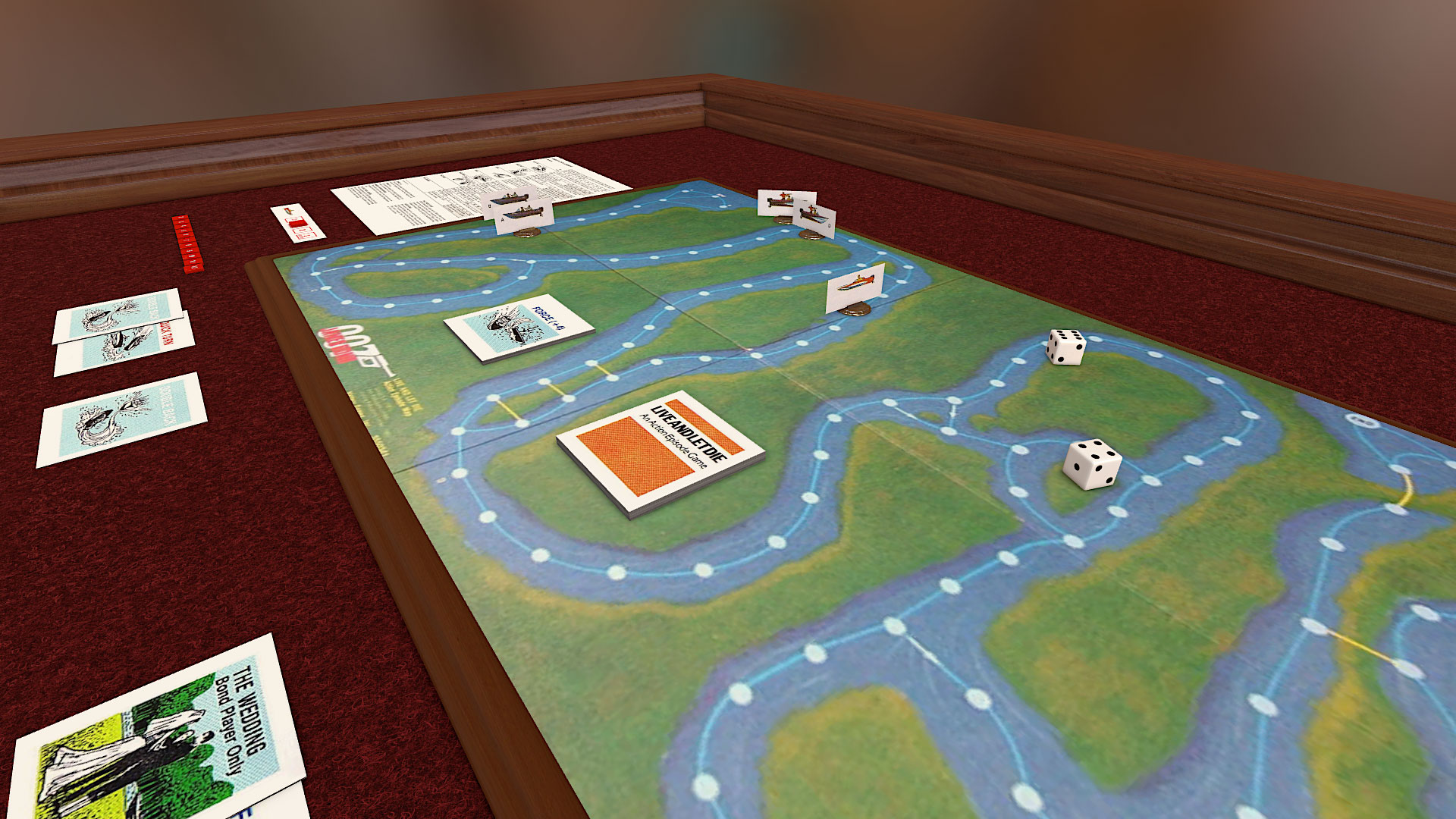
This game also has action cards. Most of them allow you to take all the standard actions without suffering a penalty, while others let you add roads to cut the river, bring a blockade or distract an enemy (or Bond) using the sheriff and some are specific to a team – the enemy can play a special shot card which slows Bond down, while Bond has one card that can heal his boat – the right player getting one of these cards can make a huge difference.
---

007 James Bond: The Man with the Golden Gun (Victory Games)
- Original Release: 1985
- Developer: G. Christopher King
- Publisher: Victory Games
- Platform: Board Game
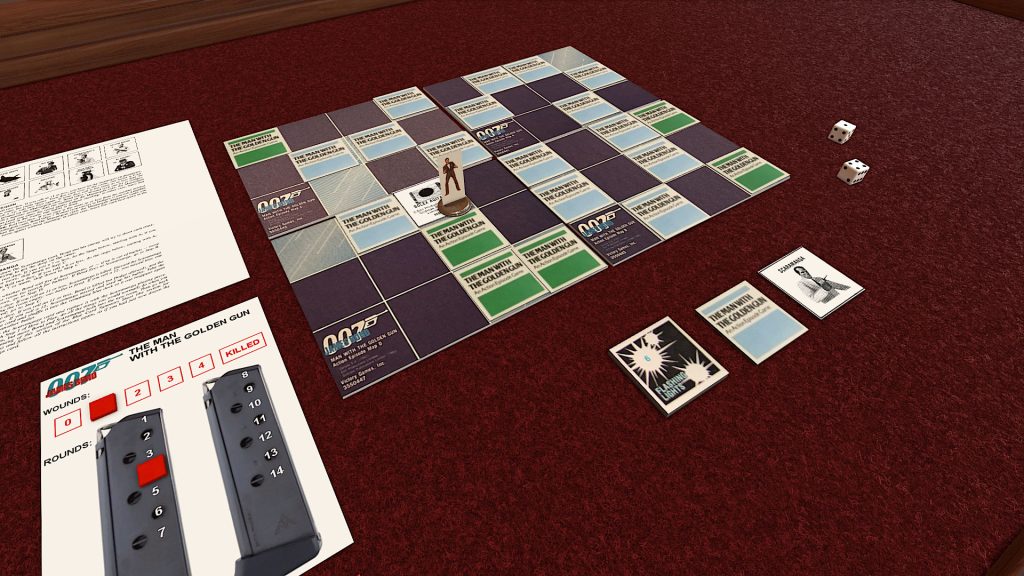
This Victory Games James Bond board game is a departure from the previous three – this one is a solo game with completely different mechanics. This one challenges the player to make it through the maze from The Man with the Golden Gun, finding the Solex Agitator along the way.
There are four “boards” that make up the map, but you only start with one. The lighter blue spaces are rooms, while the darker spaces are walls. Rooms get filled with green cards. As you move through each room, you flip over a green card which will have something that startles Bond, you roll both dice, if you roll higher than the number, Bond will automatically shoot his gun. If you roll the same or lower, you can choose if you want to shoot.
After you or the dice have decided if you’re shooting or not, you then draw a blue card for the space. Some will just waste your limited bullets if you fire, while others (like mannequins) will shot you if you don’t shoot first, you have a limited number of hits you can take. In the second half of the cards are Nick Knack, Scaramanga and the Solex Agitator.
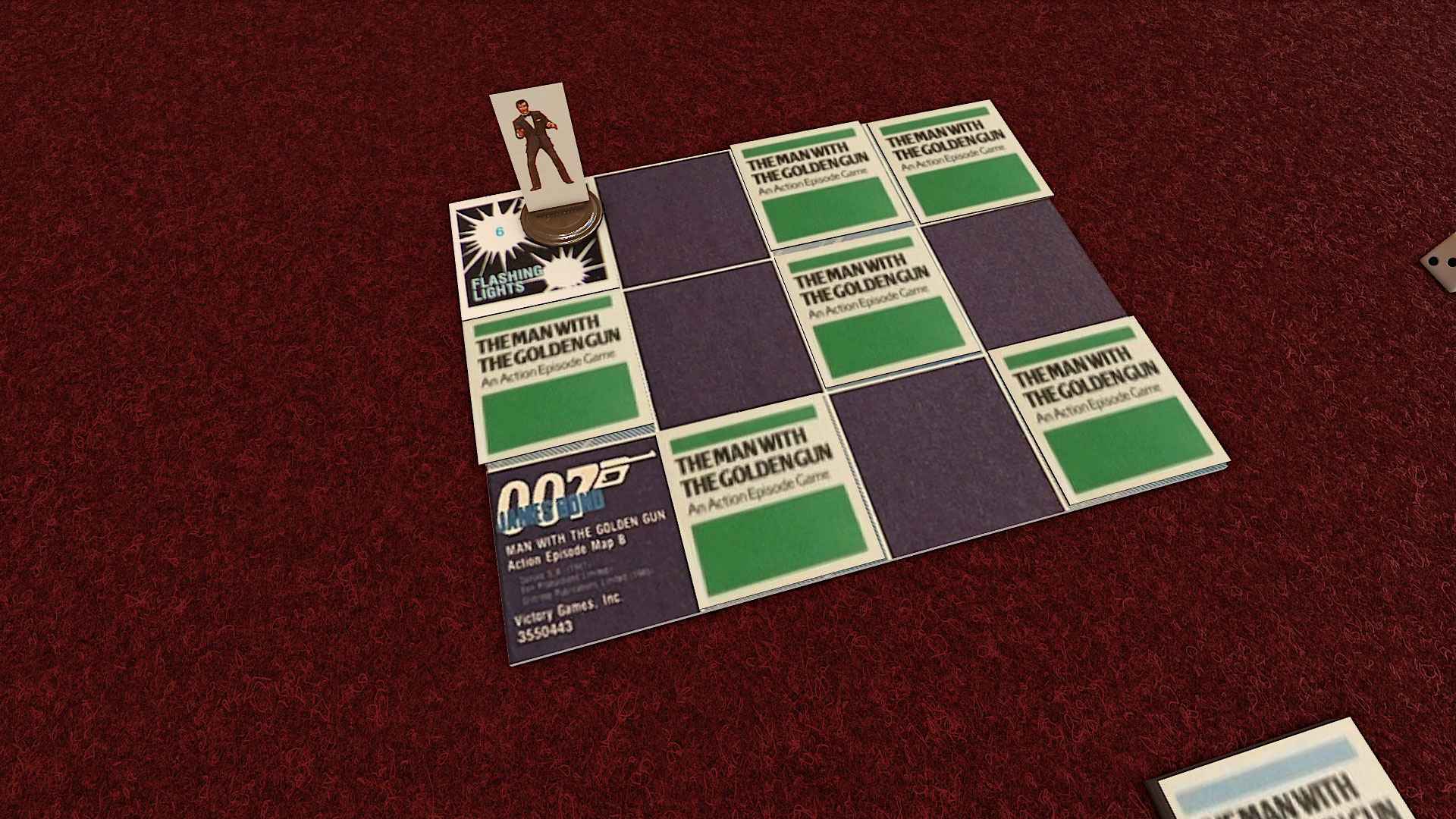
Nick Knack will likely die if you decide to shoot, but if you risk not shooting, there’s a chance to roll to convince him to stand down (he will give you extra bullets). Scaramanga is a 50/50 chance of getting killed, which really shows just how much of this game is luck-based. There are also some “maze” cards that force Bond to move in a certain direction, but these can block the rest of the map and make it impossible to continue. The game doesn’t list this as a way to lose the game, but also doesn’t explain what to do in this situation.
It’s an interesting game as it does get the feeling of wandering through a confusing maze in a daze across, but it’s an entirely luck dependant solo game – even the choices you can make are just picking at random – which isn’t a lot of fun.
---

James Bond 007 Assault! Game
- Original Release: 1986
- Developer: G. Christopher King
- Publisher: Victory Games
- Platform: Board Game

This Victory Games board game works as both as a standalone game and also as an addition to their RPG in order to facilitate large scale battles into the game. It’s a wargame that uses elements of the combat mechanics from the RPG, but simplified so that each fight doesn’t take far too long. The rulebook explains that it’s an attempt to introduce wargaming to RPG players and also introduce RPGs to wargamers.
The version I used (created by someone else in Tabletop Simulator) makes use of a redesigned map which is the same layout, just nicer to look at. Like a lot of wargames, each soldier is represented by a tile with a bunch of numbers on it. The game is based on the final fight in You Only Live Twice.

One thing that seems a bit different to this than other wargames. There are six phases in a turn: each side has a movement, command and firing phase, however, the order of this is randomised, which fits to the spontaneous nature of James Bond but can make it much more difficult to strategize. Combat makes use of the D100 system with an importance on range.
I don’t have much experience with wargames, so I can’t really say how it compares, but there’s a bit too much micromanaging for me.
-
.png) 1
1
-
More Nintendo themed LEGO on the way - Animal Crossing.
Tom Nook is on standby to provide loans for buying the sets.
-

A View to a Kill: The Computer Game
- Original Release: 1985
- Developer: Softstone Ltd.
- Publisher: Domark
- Platform: Amstrad CPC, Commodore 64, MSX, Oric, ZX Spectrum
- Version played: Commodore 64

Domark – a company that later rebranded as EIDOS – got the James Bond license and made quite a few games for classic home computers. The first one was A View to a Kill, based on the film. The game comprised of five sections, although only three were gameplay segments.

The first is the opening, showing a gunbarrel and some great music. The first main level is in Paris, where you have to drive around trying to find the landing spot of MayDay, who is currently parachuting. The level is a maze, with the screen split into two: the top view is a first person perspective and completely useless (enemies don’t appear on it), the lower is a top down view where you’ll be focused on.
There’s no consistency to the map, it feels completely random. Enemies show up and you’ll need to shoot them. If you drive too close to the wall, you can get stuck and be unable to turn. The beepy rendition of the film’s theme is quite funky, though.

Next up is city hall, a point and click adventure that is astonishingly clunky to control. You press fire to enter item selection mode, scroll until you have what you want (or nothing), press fire again to enter item selection mode, scroll to select your action then press fire again to do it. On the action selection, you can select “Return” to go back to standard controls of walking around. It’s extremely fiddly.
This portion of the game is aimlessly wondering around, searching everything, trying to find coloured keys and using them on coloured doors. It’s tedious. The building is also on fire, so you have a limited time before it consumed Bond (or an item you need).

The third section has you exploring a cave and combines the previous point and click elements with platforming. If you are stationary, you enter item selection, if you’re running, you’ll jump. So the horrible controls have gotten worse.
The level is a massive maze and you need to find items to get around. There’s no fall damage, so getting down is easy, but if you don’t find the winch at the right time, you’ll be stuck. The ultimate objective is to enter a code into a bomb to disarm it. To do this, you’ll need to hunt down all the numbers, which are physical items you need to pick up, then use them in the correct order so you diffuse the bomb.
You then get treated the final cutscene where Bond is in the shower with Bond and Stacey in the shower, with Bond breaking the camera with a champagne cork.
Just like Shaken but Not Stirred, different gameplay types for different scenes does make a lot of sense. Once again, though, these sections are just not nice to play. And while the two pieces of music are great, you get tired of them long before the game is finished.
Other Versions
Amstrad CPC
The Amstrad CPC version is a toned down version of the game, but with the same gameplay and level design. In the cave level, there’s no scrolling, so the map is cut into squares. Oddly, the missions are played in the opposite order to the Commodore 64 version.

MSX
The MSX version starts in the cave level and once again has screens instead of scrolling. This version lacks the Paris chase segment of the game.

ZX Spectrum
The ZX Spectrum version is similar to the C64 version, but with simpler graphics. The final door of the City Hall level is broken, you you need to use a poke command to fix it. There is a nice artwork at the end of this level, although the other two levels don’t have one.

Oric
The Oric version completely lacks the cave level. The City Hall level is entirely in a 2D perspective and the Paris chase only has the top down view. This is the most basic version of the game.

---

James Bond 007: A View to a Kill
- Original Release: 1985
- Developer: Angelsoft
- Publisher: Mindscape
- Platform: MS-DOS

Developed by Angelsoft, this is a text adventure based on A View to a Kill. One thing I noticed about this text adventure is how good the writing itself is, so it’s no surprise that one of the writers and developers, Raymond Benson, went on to write James Bond novels.
The game is very good at understanding commands, allowing you to do some things that don’t progress the game. A lot of the puzzles involve examining objects and interacting with what you find, although one at the start has no mention of a watch you have to look at, you just need to remember that Bond checked out a watch in the film – it’s odd because nothing else in the game lacks this knowledge.
The game is extremely difficult. Not only do you need to figure out exactly what you need to do, but some events seem to happen at certain times, so if you took to many steps earlier on, you’ll completely fail. This is pretty typical for text adventure games, though, with lots of note-taking, trial and error and repeating. The quality of the writing, including all the failed attempts, make this a good text adventure.
---

James Bond 007: Goldfinger
- Original Release: 1985
- Developer: Angelsoft
- Publisher: Mindscape
- Platform: MS-DOS

There’s not really a lot to say about this text adventure that isn’t a repeat of A View to a Kill. This is another difficult but well written text adventure game. This one does follow the film a bit closer than A View to a Kill did.
---

007 Car Chase
- Original Release: 1985
- Developer: Nicholas Coplin
- Publisher: Coplin Software
- Platform: Commodore 64

007 Car Chase is an unofficial game for the Commodore 64 made by Nicholas Coplin, who made a few Commodore 64 games written in BASIC, including a bootleg version of Frogger.
This is a very basic driving game. You have a few weapons, and blowing up other cars get you points. You need to dodge other cars, make the occasional turn and get to the correct side of the road whenever the bridge appears. The game is incredibly slow, often running at 1-2 seconds per frame.
If the game ran smoothly, it would be a fairly basic but enjoyable arcade driving game with an Atari feel to it, but for a game this simple running so badly on the Commodore 64, which was capable of a lot more, makes this rather abysmal.
---
-
.png) 1
1
-
.png) 1
1
-
This Mario Kart 64 texture packs is one of the nicest I've encountered. Keeps the aesthetic of the original game, just in higher detail - the people that made it created new 3D models in the style used originally then took images of them at all angles and animations to match the original sprites.



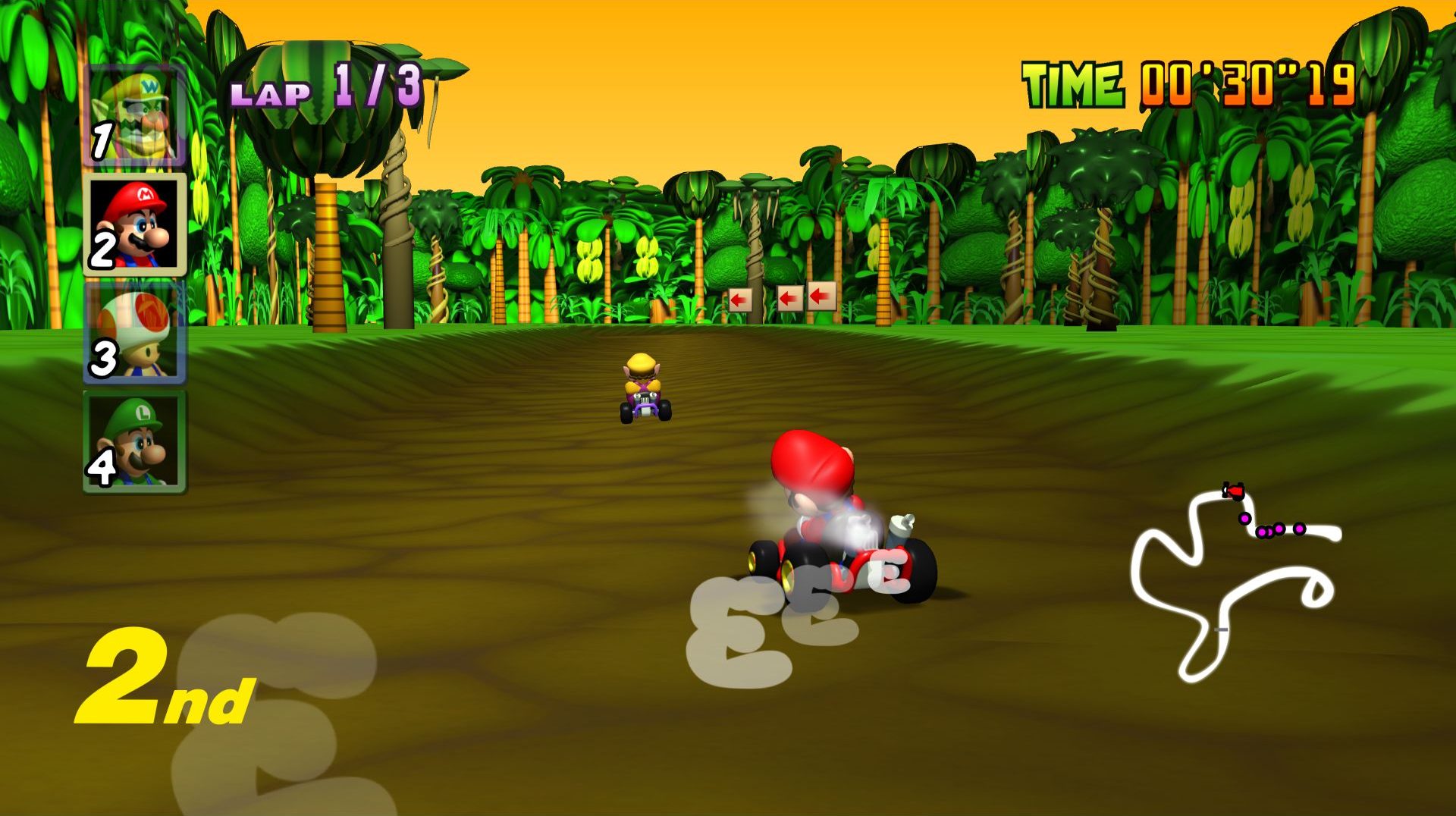
-
.png) 2
2
-
.png) 1
1
-
-
8 hours ago, bob said:Do Goldeneye!
Don't worry, I'll get to the Tiger Electronics game "GoldenEye". Or did you mean Rogue Agent?
-
.png) 1
1
-
-
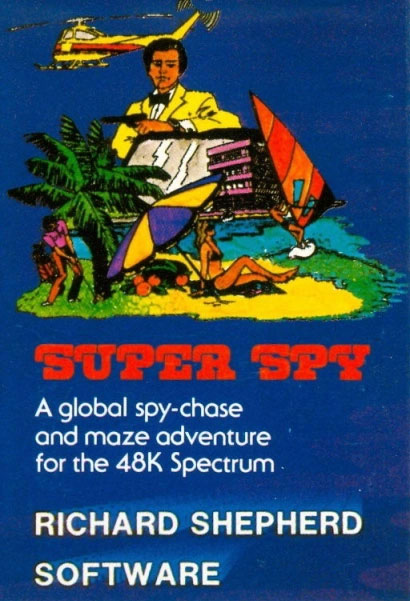
Shaken but Not Stirred
- Original Release: 1982
- Developer: Richard Shepherd Software
- Publisher: Richard Shepherd Software
- Platform: ZX Spectrum
- Also Known As: Super Spy

Shaken but Not Stirred is an unofficial adventure game for the ZX Spectrum. It was quickly rebranded as “Super Spy” (possibly to avoid a lawsuit), however the game itself was not altered, just the cover.
A jet carrying mysterious cargo has gone missing when the secret service get a ransom note from Dr. Death demanding payment or else he’ll flatten London. James Bond is sent to stop him, picking a few weapons for getting through the game. The game is split into four distinct parts, each having completely different gameplay.

The first part of the game is a text adventure. You have to search the world for clues. You type in a location you want to go to, encounter a random event and try to get clues that form an anagram. These letters may be out of alignment – for example, you may receive an F, but because the letters are five steps ahead, it actually means an A. You have to use this to work out the location of Dr. Death’s secret base.
Some of these encounters are fights, which I could not get to work as none of my prompts were accepted. I found someone else having similar problems, but their situation doesn’t work, so I just died on those parts. Luckily, the solution is the same, so you can combine your knowledge from previous attempts.

Once you reach the secret island, it continues with the text-based interface, but you have to navigate a maze. You move in directions and occasionally fight. Luckily, the prompts worked for these fights, but it’s a very simple system where any weapon will kill in one hit (you so really need to have picked the weapons with more ammo). The layout of the map is consistent, however the “connections” between areas are random, so even if you know where you want to head, you can reach dead ends.

Once you locate the secret base, you then play a very different kind of made. This is a 3D style made where you navigate using the arrow keys to turn and move forward. This part is incredibly frustrating, and it seemed like button presses didn’t work a lot, and some turns didn’t match up with the doors (for example, there can be a door to your right, but when you turn right there isn’t one in front of you). To make matters worse, PAWS (a renamed Jaws) randomly pops up to kill you, with no way to evade.

The final “chapter” of this game is incredibly disappointing: it’s the board game Mastermind. Enter four numbers and you’ll see if any are correct, and if any are in the right place. You need to work out the secret code to beat the game.
Shaken but Not Stirred has some interesting ideas, and having different gameplay for different chapters does make sense for a Bond game. Unfortunately, this game is just annoying, partly due to things not working, others due to the complete randomness. Still, for the first James Bond video game (even unofficial), it’s not an atrocious first attempt.
---
Moonraker (Atari)
- Original Release: Cancelled in 1982
- Developer: Charlie Heath
- Publisher: Parker Bros
- Platform: Atari 2600
- Not played: No leaked prototypes
Not much is known about this game, only that it was an early prototype for a Bond game. A stage based on the final mission was created by Charlie Heath, which he described as “You’re in space orbiting earth in the space shuttle, chasing bio-terrorist pods to shoot them down before they break up in the atmosphere, while your shuttle and the pod are being buffeted about by reentry. You see something that looks a bit like a spinning earth bobbing about at the bottom of the screen.”
Parker Bros turned down this game as they wanted something with Bond running around with gadgets, something more like Pitfall. A game based on Octopussy was put in development instead, until that game had its own problems.
---

James Bond 007 – As Seen in Octopussy
- Original Release: Cancelled in 1983
- Developer: Western Technologies
- Publisher: Parker Bros
- Platform: Atari VCS
- Not played: No leaked prototypes

This was going to be the first official James Bond video game, and a demo was playable at some game shows, such as the Electronic Fun Expo. It was a side scrolling shooter set on a train, where you fought goons while racing on top of the train. The game got a couple of adverts, but no footage exists.
The developer, Western Technologies, never the finished the game and the publisher, Parker Bros got another company, On Time Software, to develop a different James Bond video game.
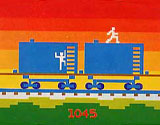
---

James Bond 007 (Atari)
- Original Release: 1983
- Developer: Parker Brothers, Tsukuda Original (SG-1000)
- Publisher: Parker Brothers
- Platform: Atari 2600, Atari 5200, Atari 8-bit, ColecoVision, Commodore 64, SG-1000
- Version played: Atari 2600

After a few failed attempts to get a developer to make a James Bond game for the Atari, Parker Brothers ended up developing it themselves. The end result was a vehicle game clearly inspired by Moon Patrol.
It’s a side scrolling shooter and you have two forms of attack: a gun that shoots into the air, and a bomb that arcs downwards. They both share the same button, so you alternate between the two, meaning you’ll fire a lot of useless shots (especially when you’re driving along the ground.

The missions are loosely based on four films: Diamonds are Forever, The Spy Who Loved Me, Moonraker and For Your Eyes Only. The missions do have objectives: find a hidden oil rig, destroy an underwater base, destroy satellites and find a hidden shipwreck. The hidden objects are found by shooting diamonds in the sky, and throughout it, you need to destroy enemies and dodge obstacles with a very awkward jump.
While the gameplay could be used for pretty much any franchise, the objectives are actually based on scenes from the respective films. While the game looks and plays like complete madness, the manual explains the objectives and all the random stuff happening surprisingly well. It doesn’t make the game good, but it at least shows effort into tying it into James Bond.
Other Versions
Atari 5200, Atari 8-bit, Commodore 64
The Atari 5200, Atari 8-bit, and Commodore 64 versions of the game are identical to the Atari 2600 version I played. Even though they had additional buttons, the fire button still alternated between the two different shot types.
SG-1000, ColecoVision
The SG-1000 and ColecoVision had a slightly different version, with the SG-1000 version developed by Tsukuda Original. The level layouts and objectives were the same, but the graphics are different. On top of that, you can choose which kind of shot you want to make.

---

James Bond 007: Role-Playing In Her Majesty’s Secret Service
- Original Release: 1983
- Developer: Victory Games
- Publisher: Victory Games
- Platform: Board Game

A full RPG like this is a very daunting thing to play, plus requires a ton of work from more than just one person, so I’ve only skimmed and read up about this.
The game covers how James Bond (and other agents) are the ones with the advantage, not the Games Master – the Games Master can not cheat like other RPGs, but also can’t help too much at pointing out where the players need to go. While the RPG and books are clearly based on the films, it features unique character designs plus replaces SPECTRE with TAROT (presumably due to rights issues).
The system is based on a percentile system, with bonuses for getting a higher score than 100, with specific rules for stunts and chases – this RPG is all about spectacle than simulation.
This RPG is also geared to low player counts, with rues that support just the GM and one other player.
---

James Bond 007 Agent Game
- Original Release: 1984
- Developer: Risto J. Hieta
- Publisher: Voitto Pohjola Ky
- Platform: Board Game
- Original Name: James Bond 007 Agenttipeli, James Bond 007 Agentspel.

This is a board game released in Sweden and Finland by Voitto Pohjola Ky, I have translated the rules and event cards into English for my recreaton.
This is a roll and move game where you’re all competing to identify which of the six crime families have stolen nuclear warheads. At the start of the game, three cards from one of the families is removed at random (leaving one card behind). All but these three cards are then shuffled with the event cards. The three hidden cards are from the family that have stolen the weapons, and the other players have to figure out what family that is.
Players will do this by moving between cities. The first player to enter a city will remove the token on it and draw a card, showing it if it an event card or placing it face down in front of them if it is a crime family card. If one player collects three from the same family, they have to reveal them, but get a cash reward for it.

Money can also be used to move around quicker: you can charter flights between some cities or hop on a ferry. You can even buy a helicopter or car to permanently improve your movement. You gain money from gambling at casino cities: you pay $100 and roll the dice. If you get a 1, you lost it, roll anything else and you’ll get that number multiplied by 100. Some event cards will give (or take) money away. You can also pay $300 to another player to look at one of their cards, helping you eliminate suspects.
The investigation part of this makes it a bit more than a simple roll and move game, and being able to spend money to negate the rolls is also a good thing, but it’s still a fairly dull game overall.
-
.png) 2
2
-
.png) 1
1
-

James Bond 007: His Beautiful Women
- Original Release: 1965
- Developer: Hanayama
- Publisher: Hanayama
- Platform: Board Game
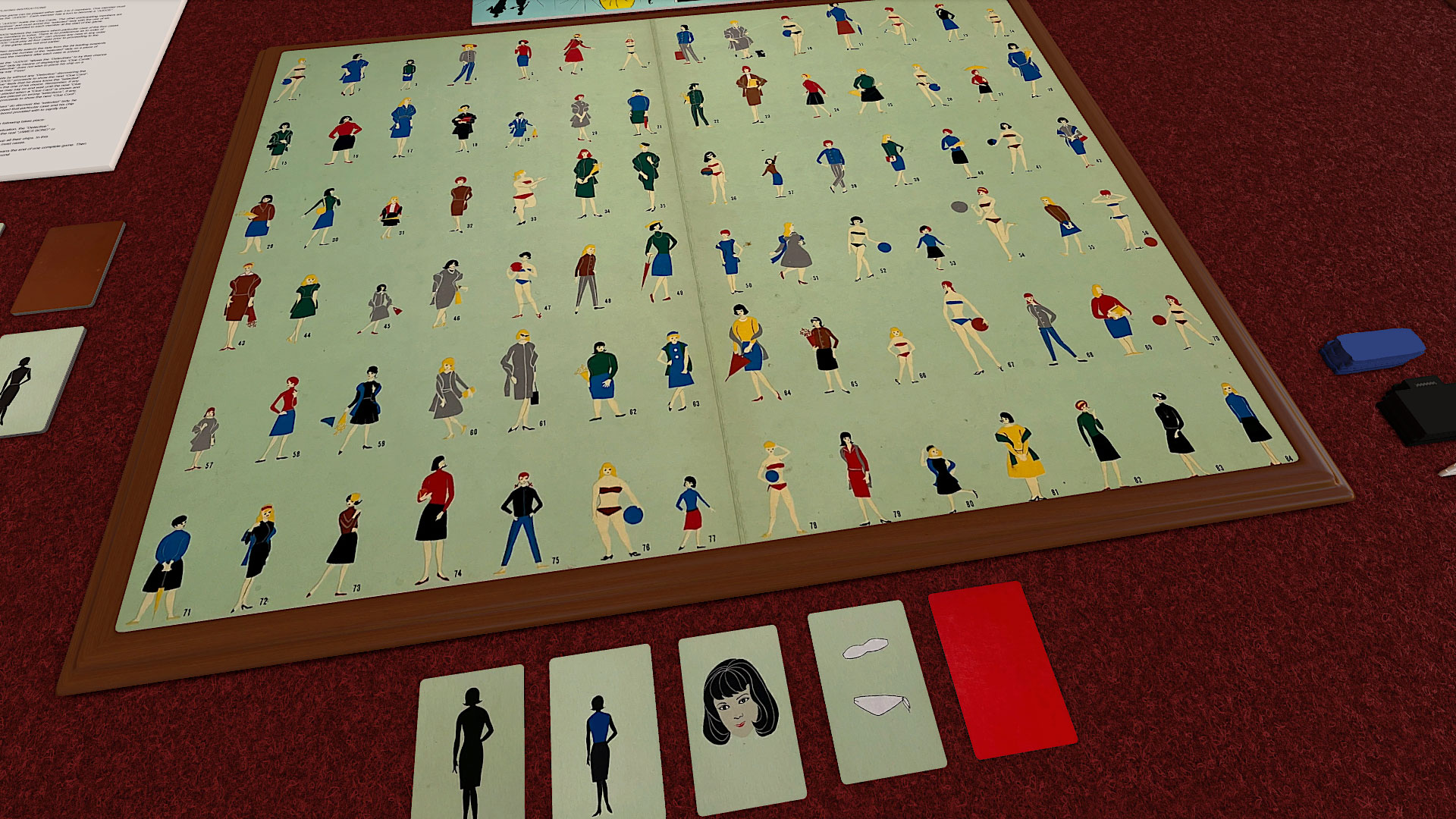
This is a very rare Japanese board game from Hanayama. I initially managed to recreate the game based on some cached information on Bing (which didn’t have the cards), but then Toys of Bond sent me nice photographs of their copy so I could recreate it more faithfully.
In this game, one person plays as a judge and has to give clues as to which of the women on the board is a spy. They do this by playing cards showing hair colour, clothing style, clothing colour, body size and accessory. After each card is played, the other players take turns placing their token on which girl they think is the one the judge is aiming for. However, you only have six tokens across four rounds, so you need to be careful not to use them all up.
It’s a simple game, but not very exciting. The link to James Bond is quite weak and the game could have any theme.
---

Secret Agent 007: The Game of International Spies
- Original Release: 1966
- Developer: EPA
- Publisher: EPA
- Platform: Board Game

This is an unlicensed James Bond game from Greece, and is a very simplistic game. There are 16 embassies and your job is to steal the “black box” from as many as possible. An “envelope” is revealed that matches an embassy and the first player that gets there takes it.
You take turns rolling the dice and moving that many spaces. That’s all there is from the game, it’s a basic luck-based roll & move game.
The game design is also a knock-off of the board game “Spy Ring” by Waddington’s, although the rules of this version are much, much more basic.

---

James Bond 007: Goldfinger Game
- Original Release: 1966
- Developer: Milton Bradley
- Publisher: Milton Bradley
- Platform: Board Game

This Goldfinger game is loosely based on the Vault fight from the film. It’s an abstract strategy game: Bond’s me are trying to capture Goldfinger, while Goldfinger is trying to escape.
You take turns moving your men around. They can be moved in a straight line as far as you want until they hit an obstruction (another figure). If you have two of your men surrounding one of your opponent’s piece, you will remove them from the game.
Goldfinger is safe when standing on his exclusive centre square – Bond needs to completely surround him on all four sides to capture him there, although standard rules apply everywhere else. While the number of pieces seems unfair (Bond has a lot more), the game is balanced as Goldfinger just needs a clean run to the edge of the board to escape and win.
This game is a version of an ancient game called “Tafl”, which is sometimes referred to as just “Viking Game”.
---

James Bond 007 Message from M Game
- Original Release: 1966
- Developer: Milton Bradley
- Publisher: Milton Bradley
- Platform: Board Game

A lot of the charm of this game is in the physical component, it has a lot of neat 3D parts, a decoder and a fancy device which spins your movement number and has a soldier pop up if you’re unlucky. The Tabletop Simulator version is quite flat, with dice mimicking the effects of the main device.
In Message from M, you are trying to be the first agent to capture one of the four villains, who each have their separate sections: Largo, Goldfinger, Dr. No and Rosa Klebb. To do this, you have to consult the Letter from M Device.
You stat off with a hand of 5 cards, these depict one of the villains or Bond. You play one of these and you’ll be working on that villain’s section (if you play a Bond card, you can choose). You then consult the Message from M device, which will give you a movement number and a bonus (either equipment or a Message from M card). After this, you pull the trigger to see if the SMERSH soldier appears – if he pops up, you lose your turn.

If you get past the soldier, you first move the villain forwards or backwards – you want to get them to the last spot, but also want to block your opponents. You then move your piece forwards towards the villain, the aim to trap them in the last spot of their section. You can then push your luck to try again – although if the SMERSH soldier pops up now, you’ll be forced to move backwards. When moving the villain, if you can land exactly on an opponent, you can send them back to the start of the section – although equipment can be used to block this.
The Message from M cards look like nonsense, so you’ll need to use the plastic decoder to find the message – each card actually has two messages (although the rules don’t specify how you choose which one to use). These can help you move, make you miss turns, get you equipment and other random effects.
With the actual components, I can see this being a silly but fun game that will entertain kids.
---

Licence to Kill (Golden Wonder Crisps)
- Original Release: 1967
- Developer: Golden Wonder Crisps
- Publisher: Golden Wonder Crisps
- Platform: Board Game

A card game from the crisp manufacturer Golden Wonder. In “Licence to Kill” you are trying to capture four Bond villains, but nobody else knows who you are after.
You start off with four cards, each turn you draw one and then discard one (you can draw from the top of the discard pile if a card you want is there). You keep doing this until someone has the four villains matching their objective card.
There is also a “OHMS” card which lets you swap for a discarded card as soon as it is discarded.
It’s a fairly simple card game, but a decent filler.
---

James Bond 007: You Only Live Twice (Tri-Ang)
- Original Release: 1967
- Developer: Tri-Ang
- Publisher: Tri-Ang
- Platform: Board Game
- Original Name: James Bond 007: Si Vive Solo Due Volte

This Italian board game is be a roll and move game (well, spin an move) loosely based on You Only Live Twice, with players moving across numbered squares and lots of routes off to the side. This takes a snake-and-ladders style game and just makes it much, much worse.
For starters, it’s really long: over 360 squares if don’t hit any diversions or get made to move backwards. You spin the spinner in the middle (it’s important to note that this has a 0, so essentially miss a turn) and move that number of spaces.

If you land on an arrow, you need to start moving along the “cul-de-sac”, you have to move all the way along to the end and back before you can start along the main path again. If you land on one of the numbered squares, you’ll need to go back to the instructions to see what happens.
Most of these are “lose three turns”, although there’s even a “lose four turns” and a fair amout are “return to start”, even ones later on. A very small number are positive, but even then it’s just a measly move forward two spaces (and some of these put you on a cul-de-sac). There is some flavour text that works through the events of the film.

If anyone can ever be bothered playing long enough to make it to the end of the main track, you move onto a small final section. Here you use a spinner with different numbers and there are no obstacles. You do need to roll an exact number at the end to win.
Even for a roll and move game, this is particularly terrible. It’s long, tedious and just makes you skip turns or start again a lot. You also have zero input on the game, it’s just do what you’re told.
---

James Bond 007: On Her Majesty’s Secret Service (Italian Board Game)
- Original Release: 1967
- Developer: Unknown
- Publisher: Unknown
- Platform: Board Game
- Original Name: James Bond 007: Al Servizio Segreto Di
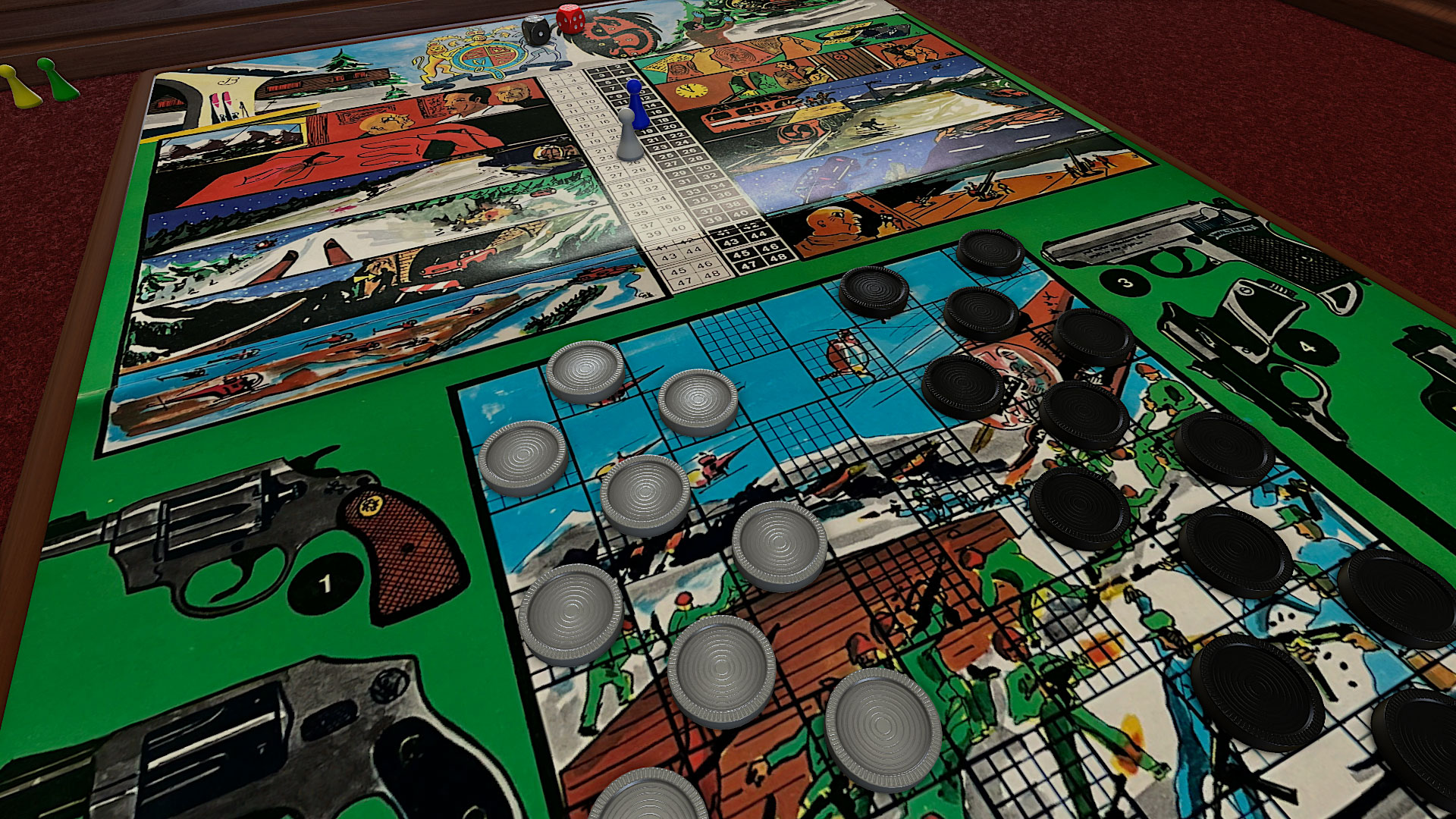
An Italian board game from an unknown publisher. I manged to find information about it on Toys of Bond, who provided me of high detailed imagery of the board, components and Italian rules. Using Google Translate as a base, I translated the rules and they seem incomplete, and the full components don’t seem to be in the game.
The first stage of the game is simple: One player is Bond, one player is Blofeld. You roll one dice and move that many spaces. Some spaces will make you miss a turn, others will let you roll again – although these aren’t marked on the board, you have to keep looking at a chart in the rules.
When this is over, the game then says that you start playing a game of checkers on the bottom. Quite how this relates to the first half the game, I have no idea. The idea behind it makes sense in: the original movement is the actions of both Bond and Blofeld in the film, while the checkers is the final battle as Bong brings allies (the rules mention this much).

My interpretation is this: when one player reaches the end of the track, the game of checkers starts. This player then gets to upgrade on of their pieces into a king (representing the main character). They take turns playing checkers as normal, with the second player also moving their character pawn. Once they reach the end, they can upgrade one of their checkers into a king, but only on the row closest to them (representing them joining the battle late).
The artwork on the board has a great style and the whole thing certainly has a unique look, but really it’s just a roll and move game that leads to a (potentially) slightly different game of checkers.
---

Moonraker Card Game
- Original Release: 1979
- Developer: Heraclio Fournie
- Publisher: Heraclio Fournie
- Platform: Board Game
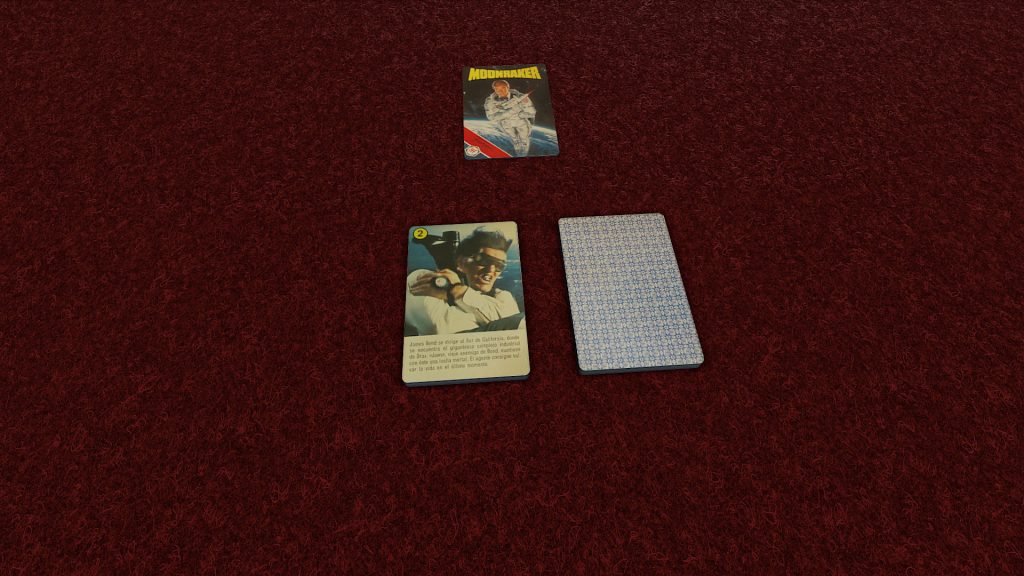
This Spanish card game contains the cards 1-8 in four colours. Each one has an image and information about the Moonraker film.
The game itself is a variant of Uno: one card is revealed and you have to match the colour or number, with the aim of getting rid of all your cards. The cards numbered “5” are wild cards which can be placed on any card and the person that placed it choosing what colour it represents.
---
The next update will have the first James Bond video games - one unlicensed, one official.
-
.png) 1
1
-
As I'm posting my James Bond games, I'm now playing though all N64 games. Some of these are Japanese only, which is a language I have zero understanding of. There are some translation guides (and even translation patches) for some games, but I'll be relying on my phone for some of them:
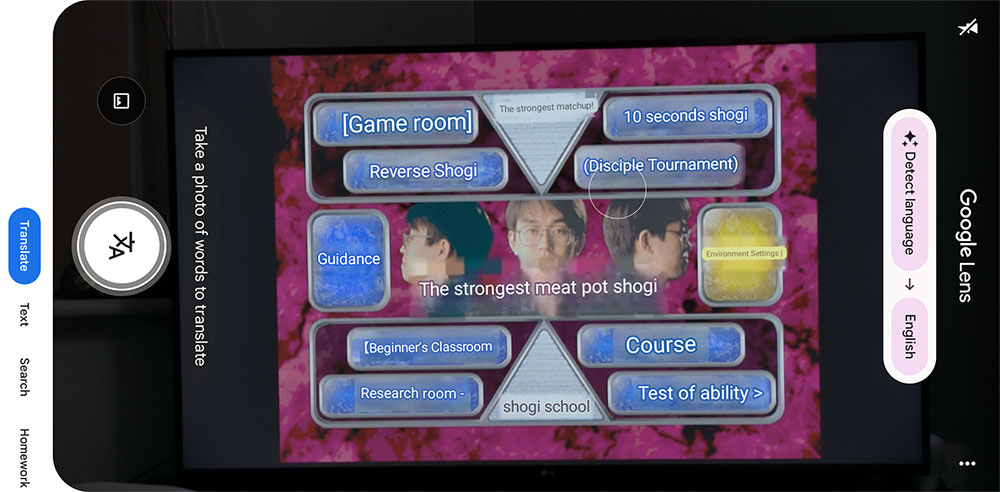
I'm sure it will be a very botch job for any dialogue-heavy games, but for menus and stuff like that, it's pretty good - translating old retro games live from your phone is pretty sweet.
-
.png) 1
1
-
.png) 1
1
-
-
I wonder how optimised the game will be on PC. I just want to play the DLC.
-
Just now, Dcubed said:Congrats on reaching the end

It's interesting to see just how many board and card games were made for Star Trek, not as many video games as you'd think.
Which one is your favourite overall, now that you've seen 'em all?
My top three games are:
Star Trek Bridge Commander
Star Trek Voyager: Elite Force
Star Trek Resurgence.
Bridge Commander will always hold a special place in my heart due to the amount of modding I did with it, and assisting other modders with their mods. Elite Force is simply a very solid FPS game with the great Voyager tour, and Resurgence is just a really well done plot with gameplay that keeps you engaged in it.
-
.png) 1
1
-
-
While I was posting about playing Star Trek games, I've managed to play all James Bond games (with a few lost flash/LCD/mobile games I couldn't play). Rather than doing roughly 7 games on a weekly basis, I'm going to separate them out differently, although still in date order. Board games and non-main games will be in bigger batches while the main games will have a bit more time to focus.
The first two updates will be just board games - there was a lot of early James Bond board games.
---

James Bond 007: Secret Agent Game
- Original Release: 1964
- Developer: Milton Bradley
- Publisher: Milton Bradley
- Platform: Board Game
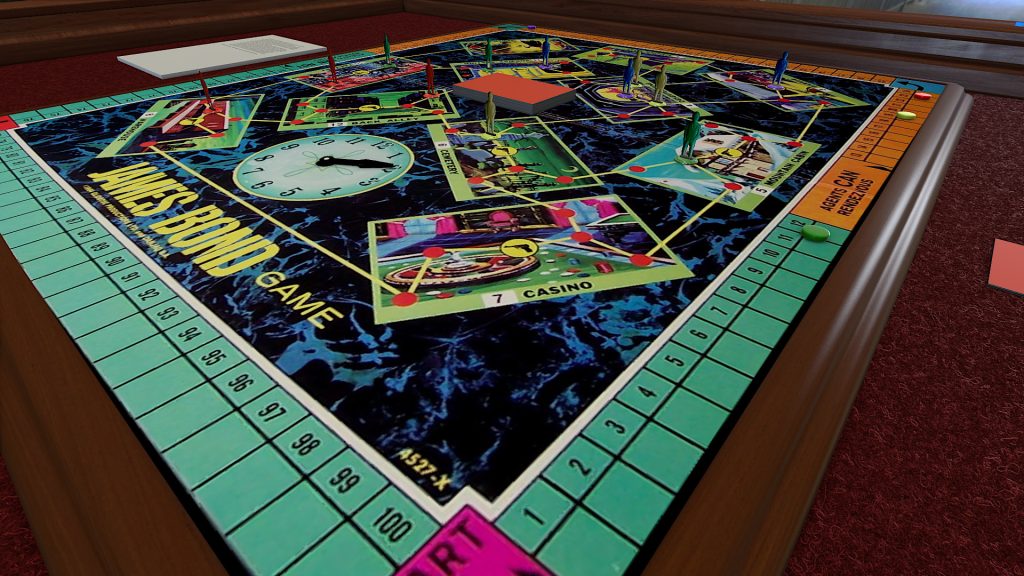
Old board games are either hard to come by, or expensive. Many are missing pieces or have other damaged. Trying to play these out-of-print games with the original physical copies is pretty much an impossible task. Thankfully, a game called Tabletop Simulator has tools that can help recreate board games, so by finding as much imagery of the components, along with pictures or scans of the rules, I can re-create these old games to play – as well as letting others play it.
This Milton Bradley game seems to be the first James Bond board game, coming out in 1964. My experience with licensed games from this era is that most are roll and move games, but this one has no dice at all. It is still, however, heavily dependant on luck, although there is some strategy involved.
Each player has three cards, depicting one of the 11 locations in the game (or a “Spy Anywhere” game). Your goal is to move to the centre of that location (to the yellow spot) and play the card to score points. You can move between 1-3 spaces.

However, for every space you move, the clock hand seen on the board moves that number of hours. If you score after your move, you score an amount equal to what the clock hand is pointing to. This means it’s not as simple as going to the locations on your cards, you want to time it just right to get the most points.
In the middle of the game, you can bonus your points by having multiple agents in the same area, if you time this right, you can store a ton of points in one go.
It’s nice to see a licensed board game try its own thing, it’s a decent idea for a board game and is quite fun.
---

The James Bond 007: Secret Service Game
- Original Release: 1965
- Developer: Jumbo
- Publisher: F.X. Schmid, Jouets Éducatifs Universels, Jumbo, Spear’s Games
- Platform: Board Game

This board game went though a few different designs, for my recreation I went with the Spear’s version – the game itself is exactly the same, it’s mainly the board graphics that are different between each version.
In Secret Service Game, you are all competing to capture the briefcase at the centre of the board. Each layer of the board has different movement rules. In the outer layer, you play airport card to move between airports. In the “car” layer, you can move one space at a time, or two if you get in a car. The “shore” layer is similar, but has boats that help you get to the island – you can also play a helicopter card to move between these points.

To get across the water, you can use a boat or play a swimming card. You’ll also need to have the relevant “gate” card to access the island. Once you’re there, you’ll need to play a card that allows you to pick up the briefcase, then make your way back to your starting spot with the same rules.
However, other players can capture the briefcase from you if they land on your spot and play the correct card. Whoever gets back to their base with the briefcase is the “real” James Bond.
It’s simple and a bit silly, but fun and beats all the “roll & move” games.
---
James Bond 007 Tic-Tac-Toe
- Original Release: 1965 (Possibly)
- Developer: Marvin Glass
- Publisher: Marvin Glass
- Platform: Board Game

There’s not a lot to say about this game – it’s Tic-Tac-Toe (or Noughts & Crosses), but one person plays as 0 and the other plays as 7. The main significant thing is the rather nice metal casing the game is made in, with rotating parts to swap between blank, 0 and 7.
---
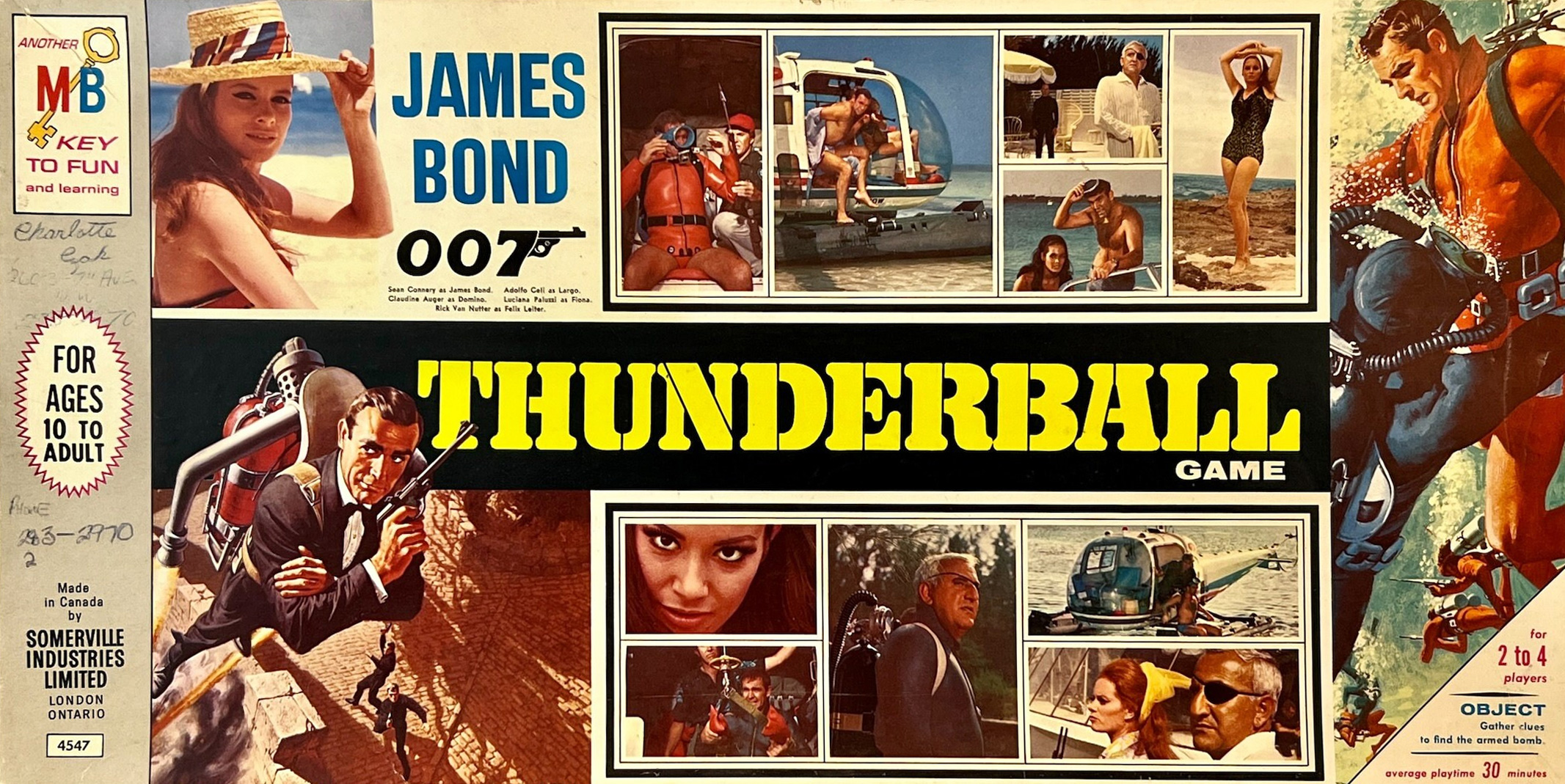
James Bond 007: Thunderball Game
- Original Release: 1965
- Developer: Milton Bradley
- Publisher: Milton Bradley
- Platform: Board Game

A roll and move James Bond board game was inevitable, but this one has some nice ideas – although clearly inspired by Cluedo.
In this game, you are travelling to 6 different areas to try and identify nuclear bombs – one of them is the real one and the others are fake. Movement is done by dice, you roll two and pick which one you want for your movement and which one to move the spectre agent (who will injure anyone he lands on), although the latter only moves in one direction.
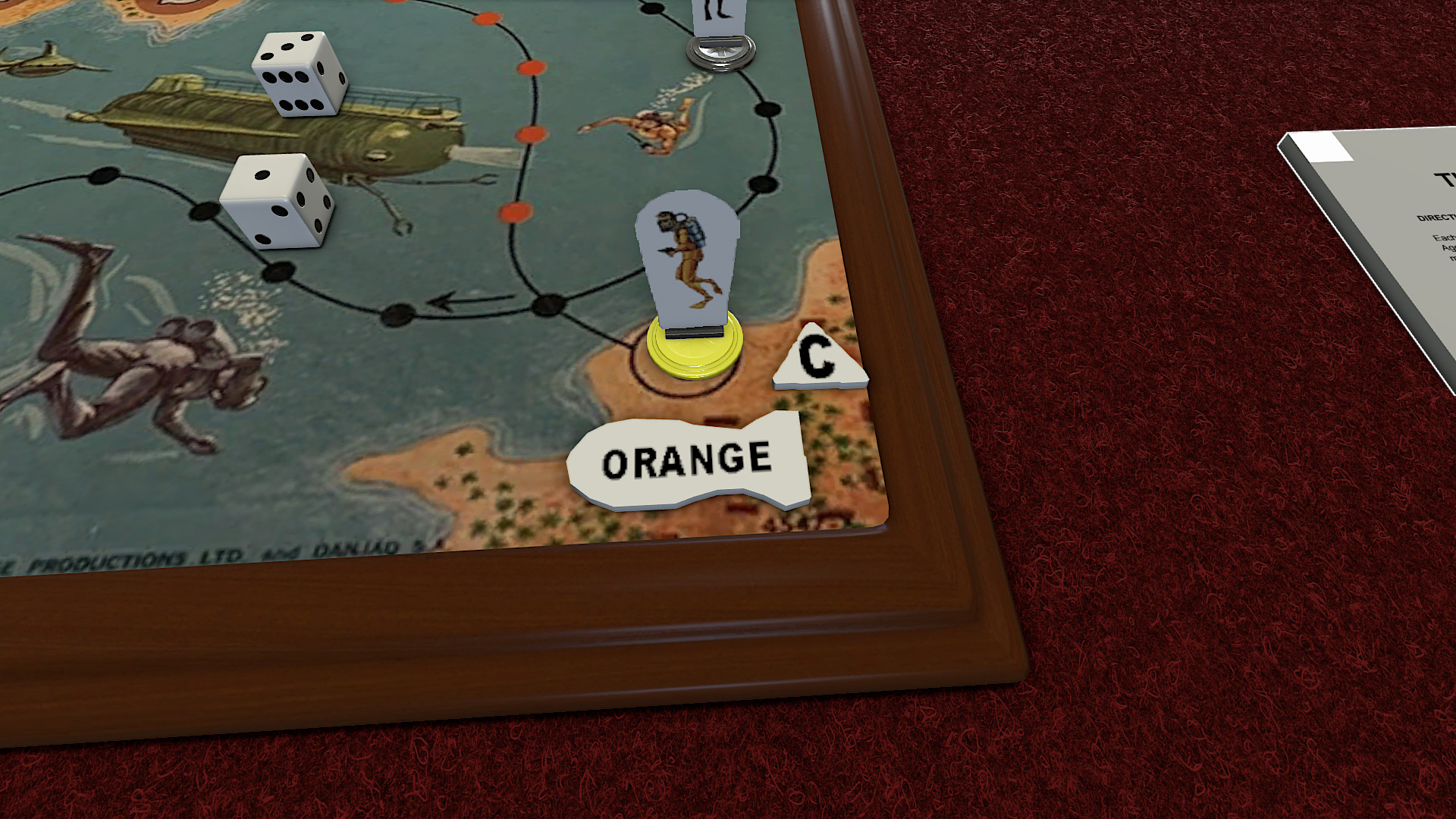
Once you reach an island (which requires an exact roll), you secretly look at the bomb and the triangle token, this will give you a colour and a letter. You then need to return to the centre island an pick a new number island to head towards. Once you’ve looked at all six bombs, you use the code on your sheet to identify which colour is the real bomb, and then head to it to win (if you figure it out early, you still need to have looked at all bombs and filled in the sheet to win).
Instead of heading to an area, you can also choose to go “on the prowl”. You can’t visit any islands, but can move around the board looking for other agents. If you land on one, you will get to look at one of their answers.
It’s quite simple, but has some nice ideas.
---

James Bond 007: Card Game
- Original Release: 1965
- Developer: Milton Bradley
- Publisher: Milton Bradley
- Platform: Board Game

James Bond’s skill at casino and bluffing games is well known from the books and films, so a bluffing game makes a lot of sense for a James Bond game.
In this bluffing game, each player is dealt three cards – these are numbered 1-7 with a “007” wild card. Two cards are face up with the middle one face down. The object of the game is to get “winning combinations” – which are three of the same number or a straight.
When you have – or want to claim you have – a winning combination, you let it be known. People can bet against you if they don’t think you do. If they call your bluff, you have to give them chips, but if they call you out and you have a winning combination, you get chips off them.
It’s simple, but a nice little filler game.
---

007
- Original Release: 1965
- Developer: Milton Bradley
- Publisher: Milton Bradley
- Platform: Board Game

This James Bond board game is an abstract strategy board game where you are trying to capture your opponent’s tiles. It’s best placed as a 2v2 game, although the rules do cover 1v1 and 1v2 versions. Red team plays against black team.
The game starts by taking turns to place tiles in a 4×4 grid. These tiles are numbered 1-5 (worth that many points) or have a 007 logo (worth 10 points). More of one colour may appear on the board than another, but the game assuses us that this is “fair”.
Once these have all been placed, the main part of the game appears. Each player picks (face down) one of their B-O-N-D tiles that matches the row they want to use. Once all players have picked, they’re placed on the relevant position. Any crossroads signifies tiles that can be “captured”. Any tiles goes to the side of the opposite colour. Capturing seven tiles ends the game, with the team that has most points being the winner.
This is an interesting little game, but doesn’t really have much to do with James Bond other than the logo on a few tiles and “BOND” being four letters.
---

007: Underwater Battle from Thunderball
- Original Release: 1965
- Developer: Tri-ang
- Publisher: Tri-ang
- Platform: Board Game

This board game is exactly what the title describes: it lets you play out the Underwater Battle from Thunderball. The game came with pre-painted miniatures, so my Tabletop Simulator version uses some simple royalty free models to represent them,: they’re not accurate, but they get the job done.
Each side has a boss (Bond or Largo) and a squad of frogmen. Bond and Largo can move six spaces, while the rest can only move four. There’s also a SPECRE submarine, which Largo has to escort to Miami or Bond has to capture and take to the US Warships. After you move, you then roll the dice and you can use this to move sharks.
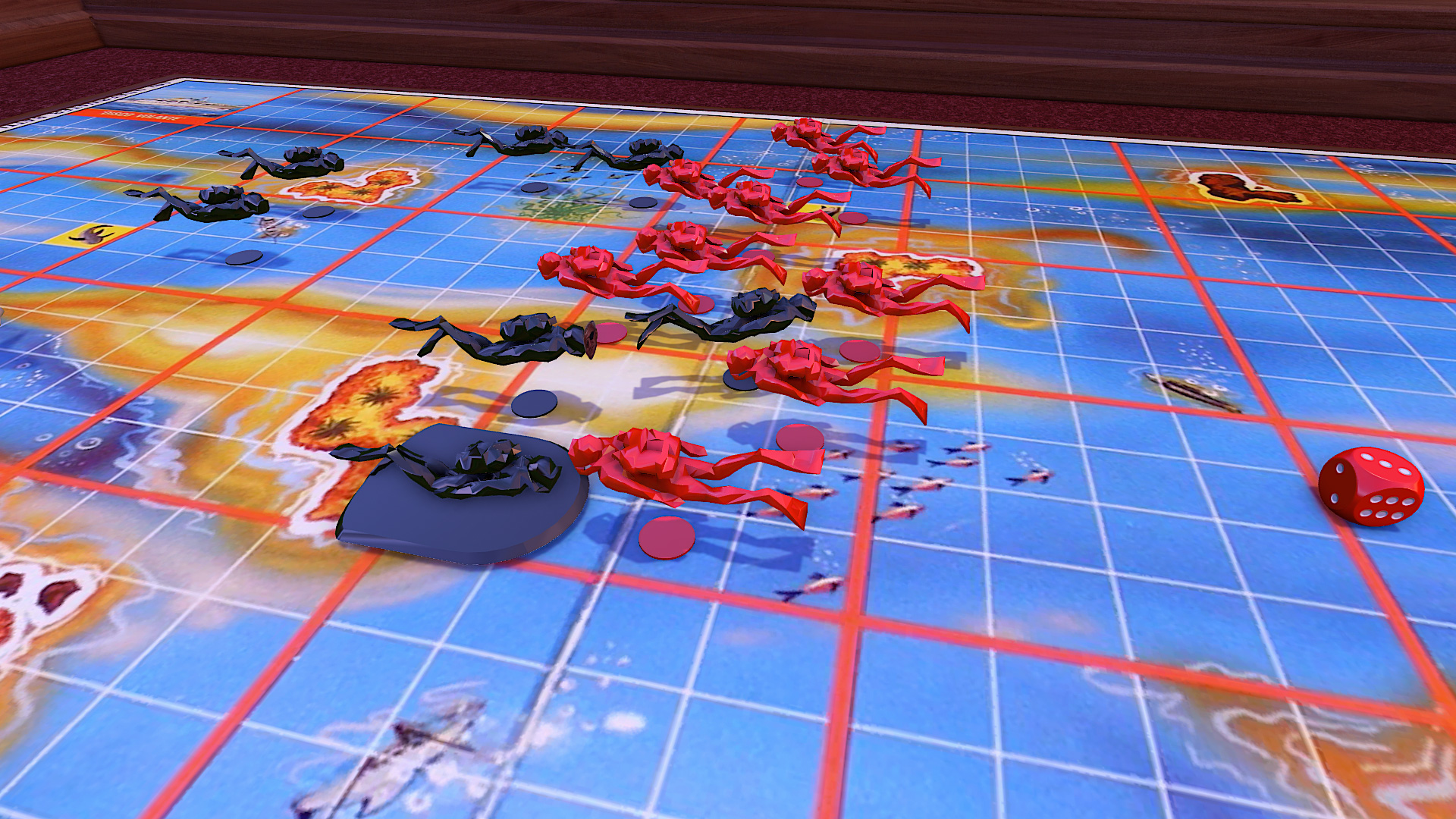
Fighting is quite simple: each larger red square is a “fighting zone”, if opponents are in one you tally up the “fighting score” for each side: 1 for each basic Frogman, 2 for Bond/Largo. The SPECTRE sub reduces the rider’s score by one. If it’s your turn, you can also use sharks to add to your score. The losing side is killed. It’s a very simple system that removes luck from the equation.
It’s a simple game that is almost pure strategy – with the slight exception of dice to help with the unpredictable nature of sharks. The physical figures also look good, so it’s a nice spectacle as well.
---
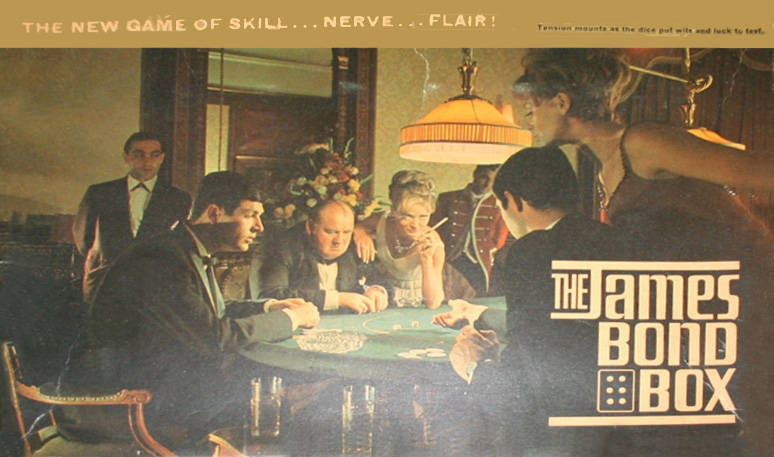
The James Bond Box
- Original Release: 1965
- Developer: Waterman’s
- Publisher: Waterman’s
- Platform: Board Game

In this game, everyone takes turns trying to open a briefcase by moving the letters of “James Bond” over numbers and uncovering all the items. On your turn, you roll the two dice and move numbers that perfectly add up to the total shown on the dice. You keep doing this until you move all the numbers or you can’t use the total of the dice, where you record your score based on the numbers you still have showing. The person with the lowest score (or any that open the box) win the game.
This game is more commonly known as “Shut the Box” and has many different versions. The box art for this one is quite nice, though.
-
.png) 2
2
-
.png) 1
1
-
Super Star Trek meets 25th Anniversary
- Original Release: 2023
- Developer: Emabolo
- Publisher: Self-Published
- Platform: PC/Browser
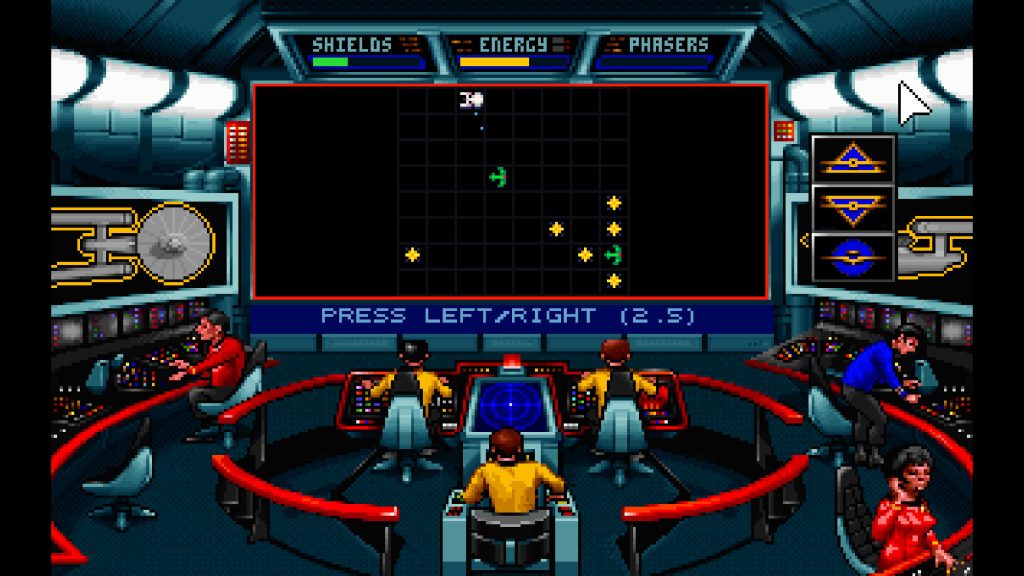
This version of Mayfield’s 1971 Star Trek game recreates the Super Star Trek version and combines it with elements of the 25th Anniversary.
The core workings behind the game are very faithful to the original Super Star Trek. In the game, you have to hunt down Klingons within a certain amount of time. Instead of a text interface, you have a point and click interface that uses the bridge from 25th Anniversary (although you can use entirely keyboard shortcuts if you want).
Navigation and firing torpedoes are the biggest changes, as these can be done by clicking where you need to go. For firing torpedoes, you have a little aim reticule that you move around the Enterprise to aim – which means you can still misjudge and miss your target, or hit stars – it takes the hassle out of it without completely removing the skill.
This is a really nice version of Super Star Trek, and even has some voice lines. It also has a few nice touch it, such as it reminds you if you enter combat with shields down.
The Roddenberry Archive
- Original Release: 2023
- Developer: The Roddenberry Estate, OTOY
- Publisher: The Roddenberry Estate
- Platform: Browser

The ultimate bridge explorer is finally here. The Roddenberry Archives brings up digital recreations of a ton of Enterprise bridges, including concept bridges brought to life. The website provides a lot of information about the various different version of the Enterprise, and what the digital recreation of the bridge is based on.
All of these bridges can be explored in full 3D. It uses cloud technology so that you get the full detail no matter what PC you’re running (although it does have to be a desktop with Chromium browser) and can walk around, interact with some objects, sit down in chairs or turn on a fly camera. With the vast amount of detail, it’s a phenomenal experience and it’s amazing to look at the bridges in detail.

It starts off with a concept bridge: the XCV-330, the ring ship Enterprise seen in pictures in films and in Enterprise. It uses an early concept for the original Enterprise, with a round holographic table and a science room above it before moving on to the NX-01, which I loved seeing in closer detail, even finding doors I never knew were there.
Then onto the NCC-1701, which gets by far the most love. It has versions of the bridge starting with a concept bridge from early production then showing us the set from The Cage, Discovery, Strange New Worlds, the TOS pilot, TOS Season 1, TOS Season 2, Mirror Universe, TOS Season 3, a live action version of the bridge from The Animated Series, the bridge from the cancelled Phase II show, The Motion Picture, Wrath of Khan and two versions of the Kelvin version bridge, each one showing different versions of the bridge.
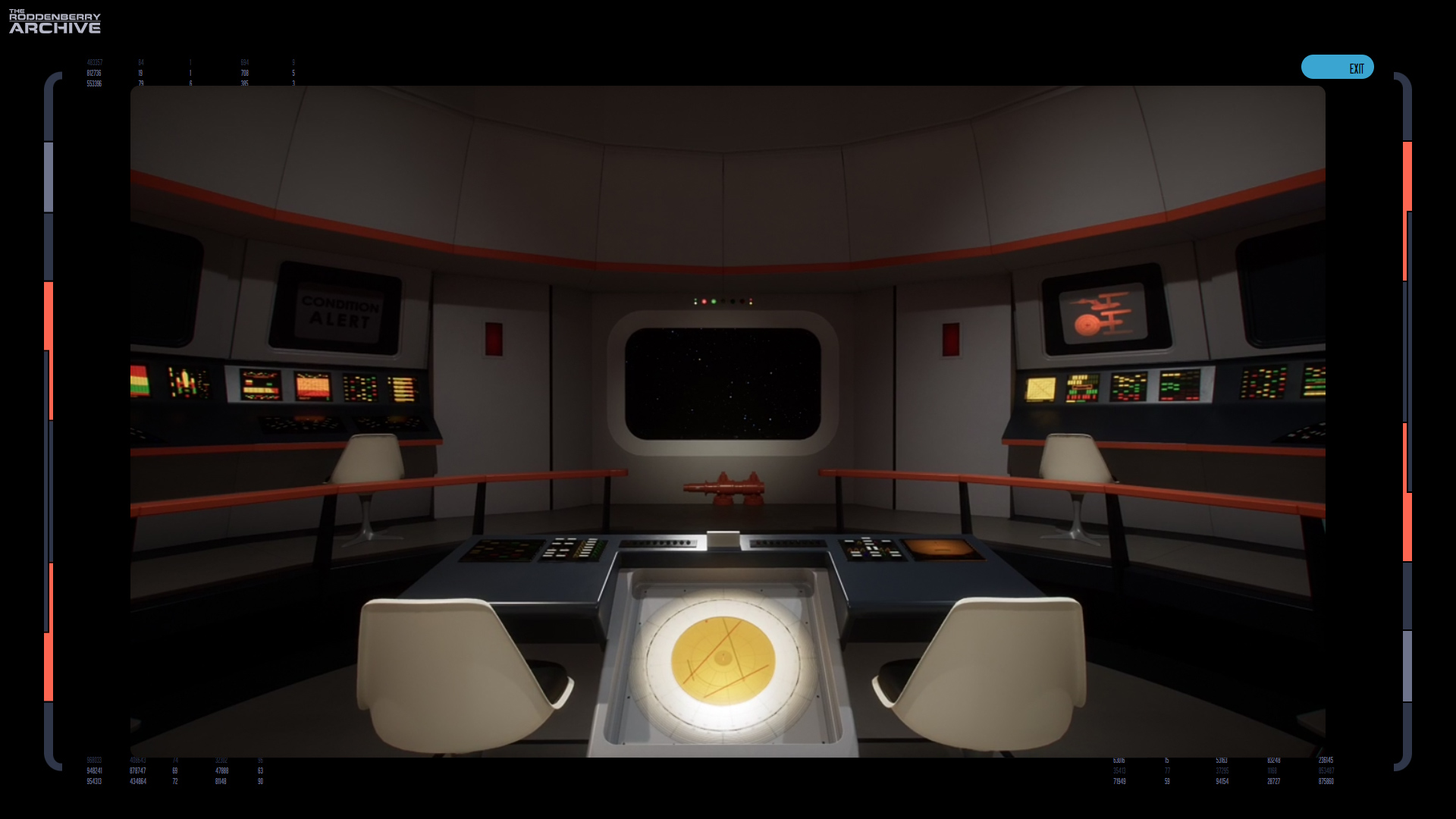
Then we get a look at a recreation of a wild concept for a cancelled film called Planet of the Titans, which featured a redesigned Enterprise from Ralph McQuarrie, which ended up inspiring the USS Discovery. It’s a lovely bridge, but not very practical.
From there we see the Enterprise A, B, C, D and E (with the D having multiple extra rooms), all looking absolutely stunning, but it doesn’t end there. It’s fully up to date with the bridges of the Enterprise F and brand new Enterprise G, which looks absolutely glorious. It ends the Enterprises with a new version of the Enterprise J featuring a see-through hull with visible cities, parks and water inside.
But it doesn’t end there, there’s a bonus Voyager bridge, with more to come in the future – hopefully we see the rest of the hero ships as well as other locations on ships, and some non-hero ships as well as alien bridges.
I look forward to the future updates of this software.
Star Trek: Resurgence
- Original Release: 2023
- Developer: Dramatic Labs
- Publisher: Burner House
- Platform: Xbox One/Series, PS4/PS5, PC

Star Trek: Resurgence is a story-based “choose your own adventure” type game from Dramatic Labs, a developer made out of some ex-Telltale staff, who have been doing this kind of game for a while.
While a few known characters do show up, this game is focused on a unique cast of characters on the science ship, the USS Resolute. You play as two members of the crew: Jara Rydek, the ships new first officer, and Carter Diaz, a lower decks engineering crewman. They’re both very likable, and the dialogue options let you have some sway over their personalities – for example, Jara can choose to fully trust her captain, or can fight to do what she thinks is right.
The rest of the crew range from likable to immediate dislike but grows on you (or you end up feeling sorry for them). Most of them are well written (the only exception is the the tactical officer, who goes psycho later on), with their characters flaws serving the story and your choices in some manner. the ship suffered a disaster before Jara was brought back on board, so you have to deal with the comradery that came out of that experience.
Due to an intense ion storm, the Resolute was picked to transport an Ambassador to the Hotari system, where previously peaceful races, the brutish Hotari and the militaristic Alydians, both species with great designs that look like something that could still be achieved in live action. The Alydians have provided technology to the Hotari, while also using them as a labour face to mine the dilithium rich moon of Hotari Prime. However, this is interrupted by the emergence of an ancient and powerful civilization. I’ll leave it there for details of the story, but it was one that I loved the entire way through the game, with lots of stunning locations that you get to visit.
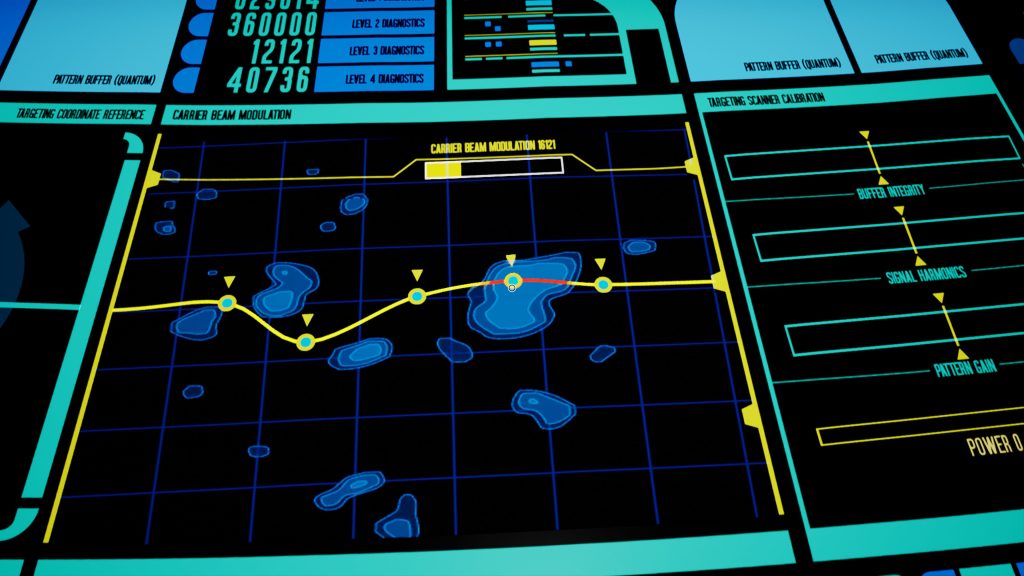
As for the gameplay, it changes a lot throughout the course of the game to meet the scene’s requirements. Most of it is spent on foot, walking around then pressing dialogue options and quick time events when prompted. Sometimes you’ll have to use your tricorder to scan, swapping between different modes to further analyse components, or a phaser, which is used for non-combat reasons during the walking sections.
There are some shooting sections, but in those you’re behind cover (and can occasionally swap cover), popping out to take shots. Other action sequences include piloting a shuttle and stealth sections. Some parts I absolutely loved was interacting with consoles, including a brilliant segment where you get to use the transporter, having to counter interference. It’s a really great depiction of what a transporter chief actually does during difficult transports.
While the gameplay itself is simple, it all helps the game feel immersive and works really well with the world. I’ve always disliked Telltale’s story games due to a “stiffness” about them that Resurgence manages to avoid. It’s a joy to experience the Star Trek Universe in this way and there are some meaningful references to a few episodes – even using a very disliked episode of The Next Generation in a great way.

I absolutely loved my first playthrough of Resurgence. The characters and story are extremely enjoyable, with lots of great different moments. The characters definitely make the game and I think it helps that this isn’t the “best” ship in the fleet – it gives a wonderful insight into Starfleet. You’ll also be given insight into how each character reacts to your choices, showing approval, disapproval or indifference, and I do like that it mentions that the character is a bit confused if you do flip-flop.
I did play again immediately after and the flaws of the game do show up – although it’s more the flaws of the genre. As the main story beats have to be consistent, some of the choices don’t matter. Plenty of them make smaller changes, including which characters you interact with, some character deaths or injuries and how some of them treat the main two. If you did your second playthrough after a break, it would be a better experience. Although I do think that the game should be better at punishing you – some of the actions you take can be pretty bad, but the consequences are very mild.
Resurgence is a brilliant game that captures Star Trek extremely well. It has engaging story and characters, and the gameplay, while simple, helps to compliment it all. It’s a wonderful way to experience a slice of the Star Trek universe.
Star Trek Cryptic
- Original Release: 2023
- Developer: Funko
- Publisher: Funko
- Platform: Board Game

From the makers of the worst merchandise in existence comes an escape room-like Star Trek board game where you work through three missions of puzzles.
From the few components you can see when you open the box (most parts are sealed inside envelopes), you can tell a lot of effort has gone into it. The tricorder looks great – with an ominous slot to plug in different kinds of filters – and the isolinear chips have texture to them. Also included is a big book with all the puzzles, a pen, a clear plastic sheet and merit points, which you get awarded as you complete puzzles. If you pull the insert out, you’ll also discover that the reverse is an engineering panel.
While this game is similar to escape room games, there are a few major differences. The puzzles are very linear, you go through the book a page at a time completing each one. Each puzzle also lists out which components are needed for the puzzle, which does take away one element of the puzzles as there’s no noticing that a mark on the box is important, it just tells you to use that part of the box. Another change is that many escape room games have a way to show that the answer is wrong without giving you the correct answer, while in this, you just proceed without collecting any merit points. Finally, there’s no timer to judge how well you do, so you can take your time to think.

While the methods of the puzzles are varied, they boil down to two types. One is more of a drawing challenge than a brain teaser. You use the clear sheet and place it over an image, drawing a couple of key locations. You then have to move the sheet away from the image (one market length apart) and then draw the path, comparing it against the scoring side of the artwork and losing merit points if you mess up, They’re nice to begin with, but are very repetitive.

The other kind involve working out a word. These are much more varied as the puzzles themselves are completely different, using lots of different components, figuring out mazes and lots more. Unfortunately, the first one was a colour one, which was very difficult due to being colourblind. Each one of these also has a hint you can look up. Lots of these involve discovering letters, with you having to solve an anagram at the end – you just have to keep in mind that some of these words can be technobabble.
Stringing the puzzles together is a well written storyline following your journey across three ships. It helps to tie things together and makes it feel more like a journey than just a series of unrelated puzzles. It’s a very interesting game, but I feel like it could be better with an optional app where you can input answers and be told that you are wrong instead of just being given the answer – it’s no fun working hard on a puzzle, making a small mistake and not getting a second chance.
Star Trek: Away Missions
- Original Release: 2023
- Developer: Andrew Haught, Mike Haught, Phil Yates
- Publisher: Gale Force Nine
- Platform: Board Game
- Not played: Only had a brief go at a convention, haven’t bought the game yet.

Star Trek: Away Missions is a 1v1 miniatures skirmish game. The base game is Federation Vs Borg, but you can get expansions for Romulans and Klingons. The miniatures have a nice style to them and are coloured based on faction, so the are easy to identify and avoid the “sea of grey” issue that some miniatures games have (unless you have the skill and time to paint them yourself).
While almost every game on this type – including previous Star Trek games – are focused entirely on combat, this one is much more objective based. Combat is still important, especially as damage can disable specific abilities to hinder your opponent’s plans for their objectives – but a lot of scenarios are done in a way that combat isn’t very helpful, and some games may have no combat at all, which fits in with Star Trek really well.
It sounds like a well made Star Trek game with nice components and a “collectable card game” style deck system.
---
So that's it for Star Trek games. There are two more due out this year - the board game Star Trek Discovery: Black Alert and the video game Star Trek Infinite.
-
.png) 1
1
-
Star Trek: Kobayashi Maru
- Original Release: 2021
- Developer: Scopely
- Publisher: Scopely
- Platform: Browser
- Not played: Login for the game is broken

Kobayashi Maru is a browser game made to promote Fleet Captains. It let you try out the Kobayashi Maru in a choose-your-own adventure style with the game giving you multiple choices. The pixel grahpics look very nice.
Unfortunately, while the game is technically still online, the Facebook login required to play is broken, so nobody can play it.
Star Trek PICO-8
- Original Release: 2021
- Developer: Emabolo
- Publisher: Self-Published
- Platform: PICO-8

This is a port of Super Star Trek to the PICO-8 system. The PICO-8 isn’t an actual console, but rather a “fantasy console” designed to allow game designers to work within limitations similar to retro consoles, but much easier to develop for. This version of Star Trek 1971 is essentially a “what if the game was ported to a handheld”.
Super Star Trek is a text-based game, while this port was made for a system with a D-pad and a few buttons, so this version allows you to select your options from a menu. The biggest change made is how moving works. It has now been separated to impulse and warp. Impulse lets you move within a system, while warp lets you pick a sector from a map. Torpedoes are now aimed with the d-pad with a short aiming dot appearing near the Enterprise.
I feel like the “limitations” set about by the PICO-8 fantasy console have helped this game a lot, this a really lovely version of the game to play, and I would probably recommend this version for someone who is interested in playing a version of the 1971 Star Trek game.
Star Trek: Alliance
- Original Release: 2021
- Developer: Josh Derksen, Thomas M. Gofton
- Publisher: WizKids
- Platform: Board Game

Star Trek: Alliance is a new game based on Star Trek: Attack Wing. It focuses on co-operative palay with up to six people (as long as you buy the game three times). Players play though a campaign of six missions, upgrading their captain and ship as they go, completing objectives and combating the AI enemies.
The base pack contains six missions in three acts. The first mission allows for retries if you fail, while the middle four missions have you press on, gaining less experience. Experience can be spent improving your captain, getting new abilities or ships (although the better ships are sold separately). The objectives involve scanning targets, protecting allies and defeating enemies. If you fail the final mission, you lose the whole campaign, so you need to spend your experience wisely.

The most vital part of this game is the enemy AI, and this does a great job at it. The process of the enemy actions is simple so it doesn’t take too much time to figure out, but the enemies do a good job at keeping you in their targets. I think they would also work as NPC enemies in Attack Wing itself if you wanted to – the systems here could be used to mix up the previous game. You can also try designing your own scenarios.
The biggest issue with this game is that, for new players, the rule book is very complicated, covering a lot of Attack Wing itself. The game isn’t too confusing once you actually play, but starting is daunting – especially when new players need to learn Attack Wing and the new mechanics of Alliance.
Alliance is a great way to expand Attack Wing, offering a new way to play.
Star Trek: Voyager: Delta Quest
- Original Release: Cancelled (Due 2021)
- Developer: GameCo
- Publisher: GameCo
- Platform: Gambling Machine
- Not played: No demo units known.

The Deep Space Nine gambling game got turned into a Voyager game, which got cancelled. From a promotional video, it looks like a “Match 3 Puzzle game” where you match gets of gems to get clues to the location of the transwarp conduit. You would be able to unlock “exclusive scenes” from the show. The Borg are on your tail and you lose if they catch up to you.
With this being a gambling game, I suspect that you would often not have the matches available to progress.
Star Trek: Lower Decks: The Badgey Directive
- Original Release: 2022
- Developer: Mighty Kingdom
- Publisher: East Side Games
- Platform: Android/iOS

The Badgey Directive is an idle clicker game set on the USS Ceritos. Boimler is doing training in the holodeck doing menial tasks when Mariner spices things up by challenging the computer to create a task Boimler can’t win – the computer recreates Badgey who then sets the crew on tasks taken from the history banks – past missions from previous shows.
The game itself is quite simple. Icons charge up, when they’re ready you tap on it to get merit points. You spend these merit points to upgrade the icons and unlock new ones, which lead to more merit points. You can add a member of the Ceritos crew to a task to collect the merit points automatically. On top of merit points, you can get latinum (which is spent to skip requirements for buying/upgrading new things, or dilithium which is spent on upgrading characters and simulations.
What makes the game work are the little story segments you get as you hit milestones. The dialogue is extremely charming and it’s great seeing the Lower Deckers take on these missions. It’s great seeing them talk about the Kelpians and Saru, and to chase the artic explorer from the Enterprise episode “Regeneration” and realise that these unknown aliens the NX-01 faced were the Borg.
Getting in the way of this game is the adverts. If you don’t watch the adverts, your merit points are effectively halved. If the adverts were harmless, I wouldn’t mind, but I was served adverts for fake apps, apps aimed at taking advantage of gambling addicts and even adverts for games about sexually assaulting women. It massively sours the experience and it desperately needs some moderation.
I got to episode 16 before I hit the inevitable “wall” where progression turned from a few hours to weeks. At this point, the chore of playing wasn’t worth it to see more snippets of the story. I would much prefer this game in the form of a digital comic.
Star Trek Prodigy: Supernova
- Original Release: 2022
- Developer: Tessera Studios
- Publisher: Outright Games
- Platform: Xbox One/Series, PS4/5, Switch, PC

Set during episodes 10 and 11 of the TV show (not based on the season 1 finale of the same name), this game follows an adventure of the Prototstar crew as they try follow Starfleet’s principles of helping others. The story has them investigate a Dyson Sphere, where the star is being drained and on the verge of becoming supernova.
You play the game as Gwyn and Dal, either with another person in local co-op or swapping between them when you want when playing singleplayer. The game is aimed at kids and is heavily inspired by the LEGO games, although there’s no platforming in Supernova, but instead a bigger focus on puzzles.
The puzzles are the game’s highlight, and while a lot are simple, some of them, particularly later on, require a bit of thinking. The game introduces more elements as it goes on, then combines it with the previous stuff. Some puzzles also have a hidden extra puzzle on top of them, required for hunting down collectibles.
Combat is against Watchers, the machines from the show. There are different kinds of watchers, such as ones that shoot and ones that charge. They can also have other properties, such as being explosive upon defeat or having a healing circle. You can use melee attacks or shoot – with Gwyn being better up close and Dal from a distance – and you’ll need to dash a lot to avoid enemy attacks. Combat gets surprisingly frantic, considering the game is aimed at kids, but the variety in watchers unfortunately doesn’t stop it from becoming repetitive quite quickly. One of the missions also crashed a few times, requiring me to re-do some long stretches of it again.
The dialogue for the most part is pretty good. It captures the show well and hints at things that the show deals with in the second half of season 1, with some good interactions between the crew and Holo Janeway. The references, however, I did notice to be oddly specific to a degree I never noticed in the show, referencing planets and locations (such as “Romulus Death Valley”) as though they were second nature, even though they hadn’t heard of Romulus until at most a few weeks earlier.
Supernova feels like an ideal game for a parent and a child to play. It does drag on a bit as it’s repetitive, but it’s got a charming story and some interesting puzzles – including some where the two characters get split in time and the player in the past has to set things up for the player in the present.
Star Trek: Missions
- Original Release: 2022
- Developer: Bruce Glassco
- Publisher: WizKids
- Platform: Board Game
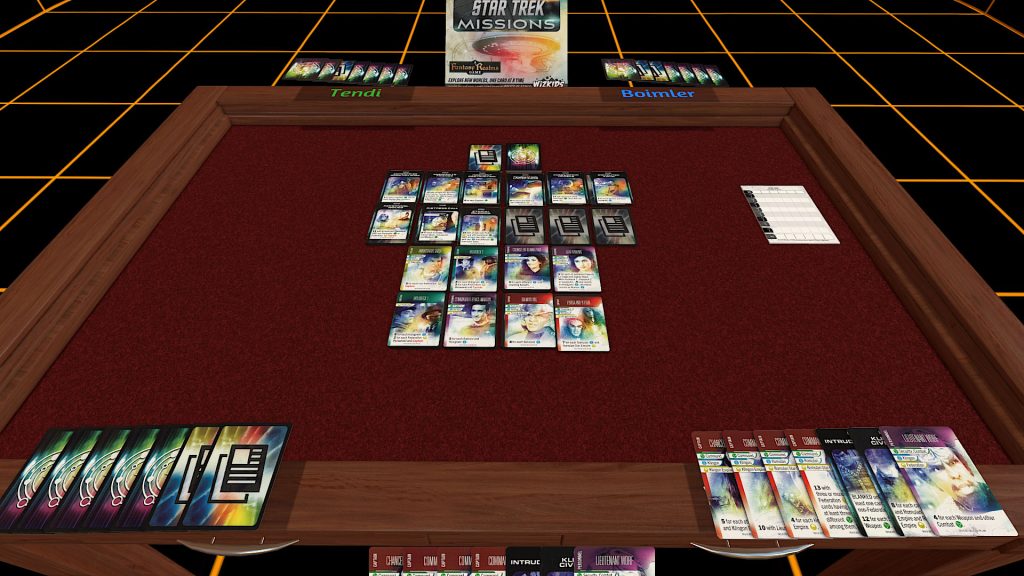
Star Trek: Missions is a game based on another board game called “Fantasy Realms”. It’s a series that I like to call “End Game Scoring: The Game”.
In this version, there are two kinds of cards: Galaxy cards and Mission Cards. Galaxy cards are characters, objects and locations and come with stats followed by how the card scores at the bottom (typically by requiring certain other cards in your hand). Mission Cards only have the scoring and nothing else. You start the game with 5 Galaxy cards and 2 Mission cards.
Each turn you draw one galaxy card or two mission cards, then discard as many cards as you draw (you must keep 1 or 2 mission cards in your hand). These cards are discarded face up in a line and may be drawn by a player instead of drawing a face-down card. Your goal is to try and form a group of cards that score well off each other.
Once 12 mission cards or 8 galaxy cards are in the discard area, the game ends and you proceed to scoring. It’s a very quick game, although the scoring part of it can take longer than the game itself.
Star Trek: Super-Skill Pinball
- Original Release: 2022
- Developer: Geoff Engelstein
- Publisher: WizKids
- Platform: Board Game

A roll-and-write pinball game with a Star Trek theme. Super-Skill Pinball is a series of similar games, and the Star Trek one brings its own twists.
Super-Skill Pinball is one of those games that sounds very complicated when trying to learn it, but is simple when you get the hand of it. Each turn, two dice a rolled and you pick one of them to “move” your pinball. You start at the top of the pinball machine and have to drop down to a lower level onto a space matching your chosen dice, which you then fill in.
Once you reach the flippers, you can then launch the ball to a space that matches the colour of the flipper, dropping down again in later turns. If there are no spaces below you that you can reach, you lose your ball. The game is played over three rounds (with one exception) and each board has unique features.
Starfleet Academy is the basic board, with one unique aspect being the “Kobayashi Maru” section which needs a roll of 7 on the dice to complete (there is a way to complete it using other parts of the board).
The Trouble With Tribbles is all about managing tribbles – you’ll keep track of your current tribbles on your backplate. You can manipulate how many tribbles you have and even transport them to other players.
Lower Decks plays differently to the others – there are no rounds. Instead, the entire board flips for every 10 points you gain. This one is a little bit broken in that you can create an infinite loop to make the game last for hours.
Borg Attack has you preparing for a Borg Invasion for two rounds, unlocking ships, torpedoes and modulations. In round three, you use what you have unlocked to fight a Borg cube, starting from the bottoms and working up to the number 6 at the top. The borg attacks your ships as the pinball bounces back and forth between your fleet and the borg.
This is a fun solo game, but I don’t think it works as well with others – due to how the game works, people will be finished and have to wait around for everyone else to finish theirs – which on some boards can be a while. Having to wait for everyone to decide what to do on their turn (everyone uses the same dice roll each turn) is also frustrating.
---
One more update after this, and I'll be up to date...until Star Trek Infinite comes out a few weeks later.
-
.png) 1
1
-
.png) 1
1
-
35 minutes ago, Josh64 said:Totally agree, I didn't even personally come across many glitches, but the loading times, especially in the town area, did piss me off greatly.
I can definitely imagine the original loading being immensely frustrating. The emulator I used was much, much faster so it wasn't quite annoying for me.
With Wii Music, I think the biggest issue was Nintendo announcing it as though it was their next major game. It made everyone treat it like it was a massively important game for the Wii.
QuoteThere's an idea, why keep remaking good games?! Developers should go back and remake flawed games into what they always had the potential to be!
I'd love for a remake of Geist. It had a really great idea and I'd love for a new attempt at it, reworking the mechanics into something better.
-
.png) 1
1
-
.png) 1
1
-
-
A few I've played of the very notorious bad games:
Big Rigs: Over The Road Racing
This is just a completely broken game, just extremely unfinished. The thing is, though, the unfinished nature is pretty much why it's bad.:If finished, it would just be a very boring and dull racing game. I played it during a charity session.
Ride to Hell: Retribution
Now this is a finished game that is utterly terrible. I also played this during a charity session, until a glitch stopped me from playing more. The gameplay itself is atrocious, the level design is bad and the story is laughable.
Sonic 06
With a couple of simple patches, it's a decent game. The fan remake of is extremely enjoyable - it shows that the core concept and level design are quite good. The game was just horribly rushed. Sonic Heroes is a much worse game.
Sonic Boom: Rise of Lyric
This is...just fine. It's mindless, extremely average but quite enjoyable. It's not a good game, but it's nowhere near as bad as people make out.
Games that I think deserve to be notable bad games:
Doctor Who: Return to Earth
My review of this was the first to be published. The game is strange: you have to collect orbs from pedestals (avoiding their "view cone") and shoot them at matching colours to activate actions. To shoot enemies, you fire a matching orb at the orb floating above their head. Aiming was immensely stiff and there's no actual challenge or interesting puzzles.
Naughty Bear
A silly Hitman clone with violent but cuddly bears. This could have worked if it was funny, with diverse objectives and interesting ideas. This had none. It was also extremely short and each level just felt like a slight variation, with you just doing the exact same thing over and over. One thing I noticed was that the menu button was very similar to every XBLA game, so I'm pretty sure this was supposed to be a cheap downloadable game that was thrown onto a disc at the last moment.
Underwurlde
One of the Sabreman games form Rare, this one is just horrible with massive falls everywhere, a confusing map with a ton of dead ends, difficult to hit flying enemies and a terrible jump.
Hello Neighbour
Apparently this is a horror game. To me, horror games completely fail when there's nothing to fear. I actually found it more efficient to get "caught" than to actually try to escape the neighbour, as you instantly respawn with all your items. The game relies entirely on moon logic and pressing buttons that activate things you can't see. I ended up using a guide and found two solutions for the first level. One involved using a fan to push something towards a button, but the fan would not push the item, so that was broken. The second was finding a hidden magnet gun, but then I accidentally hit the drop button and it fell through the ground.
12 Minutes
This is a point and click "time loop" game, but it lacks the ability to just do silly things or have fun. Even if you figure things stuff, the main difficulty is activating things so that the main character figures it out. It's mainly dialogue based but nothing you actually want to say is an option. The voice acting sounds like everyone is bored (and this is James McAvoy, Daisey Ridley and Willem Dafoe). What makes it truly terrible is the plot.
SpoilerThe main guy is informed by his wife that she's pregnant. Someone breaks into the house ties you up and asks about a watch your wife has, time loops after 12 minutes. Over time, you discover that the watch belonged to her dad, she killed him trying to run away form home and is worried about her past catching up to him.
As the plot progresses, you discover that her dad actually survived, but she had a secret brother that she never knew about that actually did murder her dad. One thing to note is that you have to watch your wife get beaten (from hiding in a closet), drug her and kill her multiple times to get this information.
Then comes the big twist: the main character IS this brother. He fell in love with his sister from afar and killed his dad (after she ran away and shot him but he survived) so he could meet her, get her to fall in love with him and marry her. Then he forgot all of this.
But it doesn't end there: it turns out that their dad survived being shot by both of them, and the entire time loop is in the main character's head - although everything up to (and including) the pregnancy announcement actually happened. Their dad is doing this to convince his son to leave his wife/sister so she can raise their incest baby (never knowing that the father is her brother) on her own - a bit too late for that, really.
It's just incredibly dumb.
-
.png) 2
2
-
-
15 hours ago, Dcubed said:Just had a thought… @Cube, will you be covering the various Star Trek pinball machines? There’s some really good ones out there, and there are digital versions of some of them that are available (such as TNG in The Pinball Arcade and Pinball FX).
I don't know much about pinball, so I opted not to cover them. There is a Star Trek pinball board game that I'll be covering soon.
-
.png) 1
1
-
-
Star Trek: Dark Remnant
- Original Release: 2019
- Developer: VRStudios
- Publisher: Dave & Busters.
- Platform: VR Ride
- Not played: Cost of getting to location and playing too expensive.

Star Trek: Dark Remnant is a VR ride arcade game that was available in Dave & Buster’s. Up to four people sat on the ride, which would tilt and turn to emulate the feeling of the ship moving.
You were a member of the USS Galileo, a science ship investigating a decaying neutron star with the Enterprise. A Klingon ship arrives, wanting to destroy the Enterprise. It’s up to you and your team to defend the Enterprise from the Klingon ship.
Your control a small handheld device which is linked to the Galileo’s weapons, enabling you to aim and shoot as objects fly across your view.
Star Trek: Conflick in the Neutral Zone
- Original Release: 2019
- Developer: Mike Elliott
- Publisher: WizKids
- Platform: Board game

A board game with a fun pun title. This is a flicking game where the goal is to collect 10 Control Points, either from destroying enemy ships or mining them from the central planet.
There are two kinds of ships: round discs are collectors. They mine dilithium or points from planets if they are still on one at the start of their turn, but are destroyed if they are knocked off. Attack ships are used to push other ships off planets or off the board to destroy them.
While it sounds simple, there’s a bunch of fiddly rules that have a lot of holes, like how asteroids work. There’s also a lot of trying to remember the location of discs in order to reset them, which makes the game a pain to play and you’ll have to agree with house rules on the fly to carry on.
Each payer starts with basic Federation or Klingon ships, but can buy ships of any faction. This means you’ll have a mixture of colours, and the names and pictures are absolutely tiny, making it a big pain to identify which ships are yours. Each non-starter ship has its own power, although these are quite random and don’t have much to do with the ship – the Defiant, for example, can move asteroids with a tractor beam. This game could be replaced with any theme whatsoever and it will make zero difference.
Flicking games can be a lot of fun, but they need to be the right kind of simple. The designer of this game has made a load of great games, but this seems like a rush job.
Star Trek Chrono-Trek
- Original Release: 2019
- Developer: Looney Labs
- Publisher: Looney Labs
- Platform: Board game
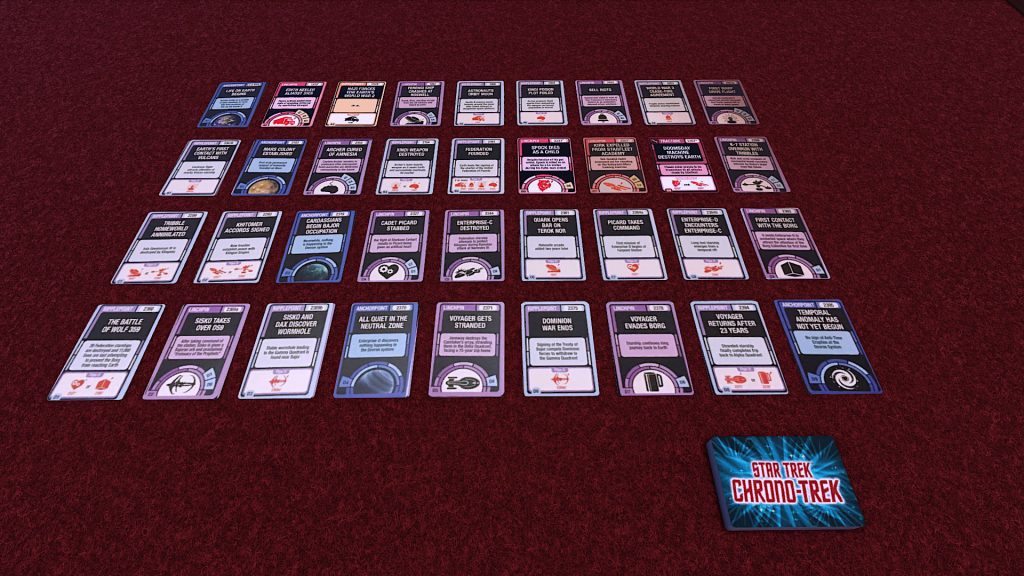
Star Trek Chrono-Trek is a Star Trek version of Chrononauts. It’s a game all about manipulating the timeline to achieve your goals.
Each card has an alternative event on the back, which players can use inverter cards to flip. Some of these can cause a ripple effect and flip over other cards – some changes need multiple prior events to be altered to impact. Each character has a list of goals on their card, which are certain timeline events (regular or alternative) or artefacts, which are found in the main deck.
Each turn you draw a card into your hand of three and then play a card – although some are events which happen by default, such as the Devron Anomaly, which moves backwards in time, wiping out humanity if it reaches the beginning.
The planning you need to make to win is unfortunately limited by the few cards in your hands. You can also only win during your turn, which means nobody can accidentally trigger a win for someone else – although if everything is right at the start of your turn, you can declare the win straight away.
Star Trek: Deep Space Nine Fluxx
- Original Release: 2019
- Developer: Looney Labs
- Publisher: Looney Labs
- Platform: Board game

The Deep Space Nine version of Star Trek Fluxx. This one has no “Ungoal” and only has three creepers, half as many as the TOS and TNG versions, so it’s (usually) a quicker game. It also contained rules for combining the different Star Trek Fluxx games without needing an expansion.
Star Trek 1971
- Original Release: 2020
- Developer: Making Games Per Year
- Publisher: Making Games Per Year
- Platform: Browser

This is a browser remake of the 1971 Star Trek game by Mike Mayfield, offering both touch and typing interfaces. The experience is streamlined massively, especially in terms of navigating and firing weapons.
It’s a very nice version to play, and a very simple way to experience the game without needing to use emulators. It does lose a little bit of its charm due to how automated everything is, moving is as simple as clicking your destination and firing torpedoes just has you selecting from a menu, which means you can’t miss, but it’s still a nice way to see what the original game was aiming for.
You can also play a Mirror Universe variant, which changes a few things. The objective of destroying all Klingons makes a bit more sense.
Star Trek: Voyager Fluxx
- Original Release: 2020
- Developer: Looney Labs
- Publisher: Looney Labs
- Platform: Board game
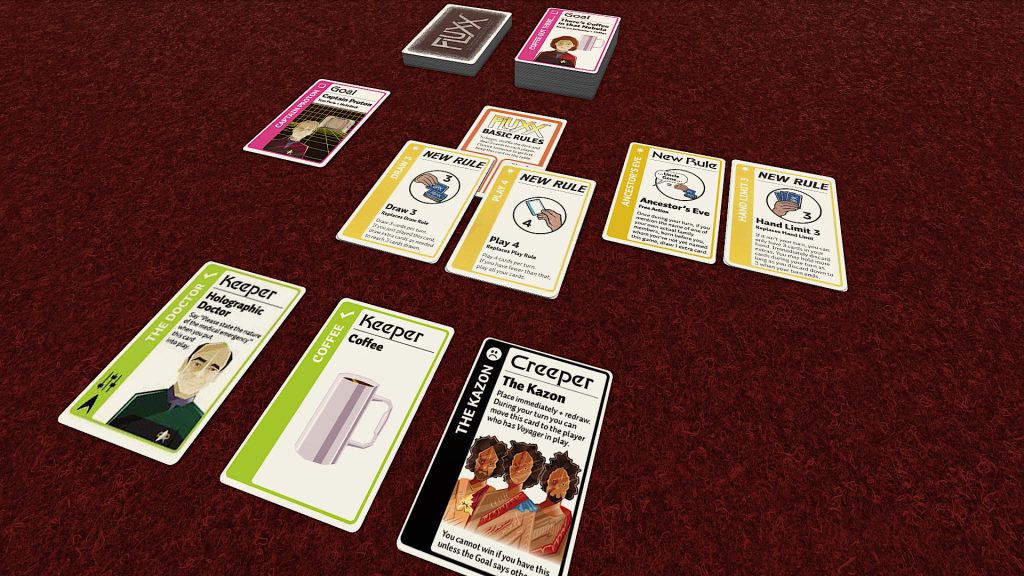
The Voyager version of Star Trek Fluxx. This has a few more creepers than the DS9 version, but no Ungloal.
There were two more expansion packs for the various Star Trek games. The Archer expansion had cards for Archer, Daniels and the Temporal Cold War while the Porthos expansion added some random things like Porthos, Spot, Phlox and Kor.
Star Trek: Deep Space Nine: Red Alert
- Original Release: Cancelled (Due 2020)
- Developer: GameCo
- Publisher: GameCo
- Platform: Gambling Machine
- Not played: No demo units known.

Developed as a “Video Game Gambling Machine”, this provided a mixture of both luck and skill to possibly win (but almost certainly lose) money on. It was going to be some kind of tower defence game and will pit the gambling addict up against “against antagonistic aliens and dangerous stellar phenomena”.
The game was cancelled in order to be rebranded as a Voyager gambling game.
Note: Unfortunately, there are a bunch of Star Trek slot machines. I have decided to not cover these, this cancelled one is an exception as it has an actual game element to it.
Star Trek: Legends
- Original Release: 2021
- Developer: Tilting Point LLC
- Publisher: Tilting Point LLC
- Platform: Apple Arcade
- Not played: No compatible device for playing.

Star Trek Legends was a game that was originally designed as a free 2 play game but is now subscription-based as part of Apple Arcade (which means I have no way to play without spending an obscene amount of money) similar to the Star Wars game Galaxy of Heroes.
While it’s no longer a free to paly game, the elements are still there, with lootboxes and a lot of grinding for new characters. The game is a turn based combat game, but because it’s all about how much you’ve grinded and levelled up your characters, strategy doesn’t really seem to matter – the game even has a button to play for you.
This one uses the Nexus as the reason why characters from all timelines have ended up together, with Burnham, Worf and McCoy being the main characters in the story.
-
.png) 1
1
-
How exactly are they tracking installs? None of the data on our computers should be going straight to Unity. Will offline installers get banned?
And with their updates: how are they going to detect installs from bundles? How do they know a second install is one the same computer without collecting private information?
-
Star Trek Adversaries
- Original Release: 2018
- Developer: Puppet Master
- Publisher: Puppet Master
- Platform: PC, Android, iOS
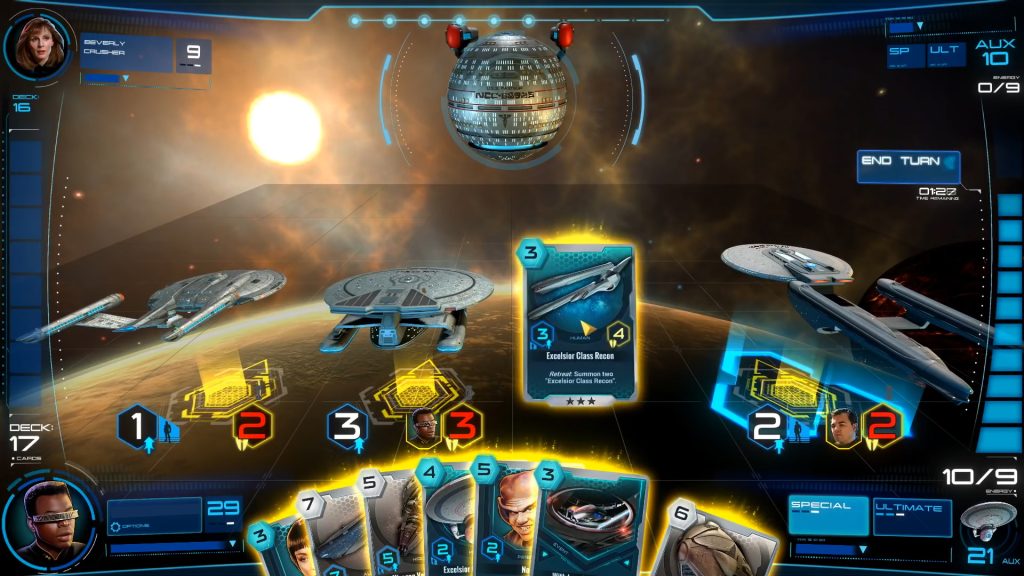
Star Trek: Adversaries was a fast-paced card game that had a good response from critics. It was a digital collectable card game that featured some really nice starship models – and quite a lot of them. Unfortunately, the game was shut down and servers taken offline before it was even live for a full year. Booting up the game just gives you a login error.
However, this is a card game, and the information on the cards was kept on the Wiki for the game, so by figuring out the rules, creating needed tokens, I was able to recreate the game in Tabletop Simulator, just without the automation. It’s doesn’t have the fancy effects or the 3D models, but I can still try out the gameplay.
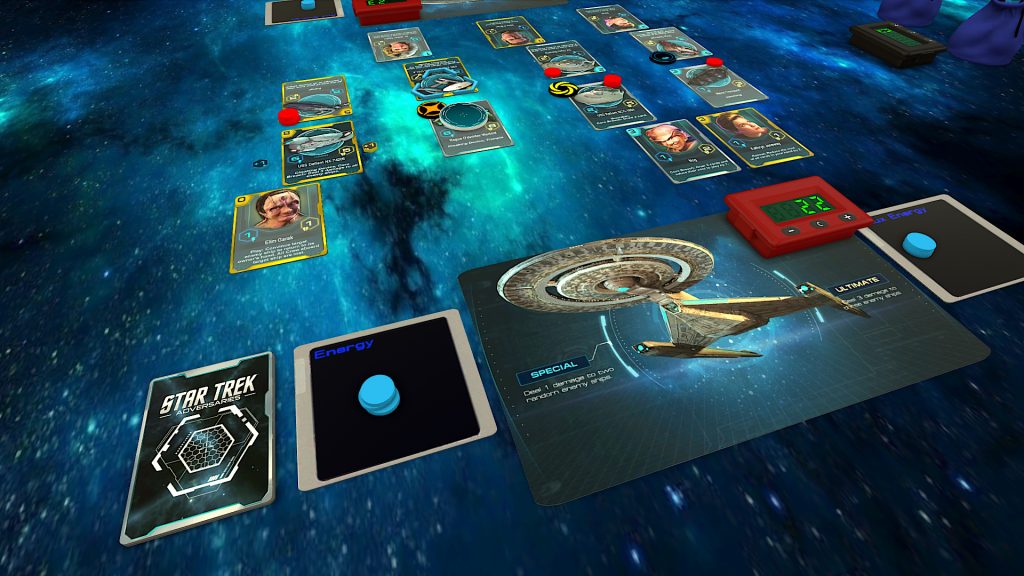
It’s a really fun game that reminds me a bit of Star Realms. Most of your cards are ships that can be enhanced by crew. You put them into play and can attack the opponents ship or their flagship – with the overall goal being destroying the flagship.
Each turn, the amount of energy you can spend on playing cards is increased every turn, leading to a game that starts out slow and speeds up massively. It also requires you to plan your deck with a balance of cheaper and more expensive cards. Leftover energy at the end of your turn becomes auxiliary energy, this can be spent on your flagships Special or Ultimate powers, which also bring into play that flagship's unique cards.
The cards cover all the shows up to Discovery, with the cards looking nice and clean with lovely artwork on them. It covers a nice variety of ships, including a lot of alien ships in the neutral cards.
Adversaries is a fun, quick game. I probably would have hated the lootbox nature of the mobile game, but the actual card game has some fun and interesting mechanics.
Star Trek Trexels II: The Next Resolution
- Original Release: 2018
- Developer: Kongreagate
- Publisher: YesGnome, LLC
- Platform: Android, iOS
- Not played: Servers down.
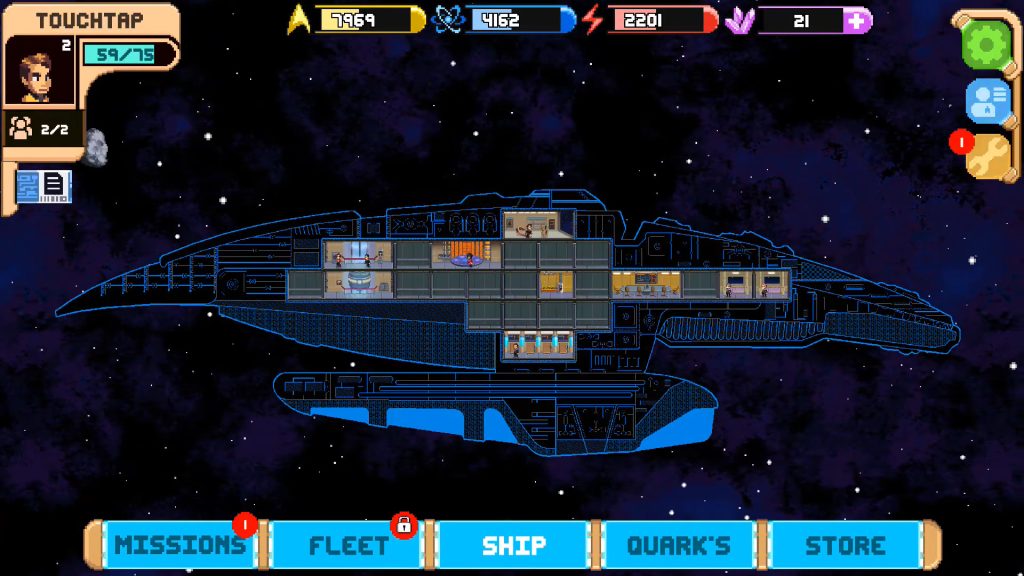
Trexels 2 brings the first game and gives it the very marketable “throw in everything from all shows” thing that the mobile Star Trek games love because it’s great for lootbox opportunities. The ship building is more of the same: lots of tapping and wait timers, with the ability to pay real money to make the progression qicker.
The biggest change are the away missions, which look like they could be interesting as they’re an X-COM style turn based strategy….but from reviews, it’s very shallow and you’ll eventually encounter missions where you need to grind forever to upgrade characters enough to complete, or pay money to do so.
The servers for this game were shut down, so there’s no way to play it.
Star Trek: Fleet Command
- Original Release: 2018
- Developer: Digit Game Studios
- Publisher: Scopely
- Platform: Android, iOS

Playing this game now, it very much has a crisis of identity. The game boots up with USS Voyager artwork and you’re given some of the TNG crew at the start, but then the state of the universe makes no sense and the game doesn’t look right and feels more like the Kelvin universe.
And that’s because it IS the Kelvin universe. Originally, the game had no additions from other shows. The game was about you being an “independent” in the changed world of the Kelvin timeline, dealing with a mysterious AI helping you created by Scotty. The stuff thrown in by other shows have no explanations, they’re just there, and end up making the game look like a mess (just a more marketable mess). It started off as its own coherent universe before just throwing anything in.
Fleet Command is a “press button to do stuff” game. There’s no strategy and very little choice, combat is automatic and missions are extremely repetitive. It starts out promising, looking like a strategy game with in depth base building and complex technology trees, but this is all an illusion as it soon becomes clear that everything has to be done in a specific order. Want to upgrade your drydock for more ships? You need to make sure your Academy is at the right level, which requires Operations at a certain level and so on. The entire game is like this, making it feel like you’re just doing chores for someone else.
The game is all about time management. Everything takes time, and the main collectable are speed up items that skip some of these wait timers. If you run out, you can buy more. Other upgrades, such as new crew, are via lootboxes. The crew screen looks impressive, with a good 3D model of the character, but they’re nothing more than bonus stats for your ship. It’s really baffling when part of the game is looking for Scotty when he’s sitting on on of your ships (the Kelvin universe version, too). Having these known characters detracts from the game, but it appeases those that just want to spend money to collect.
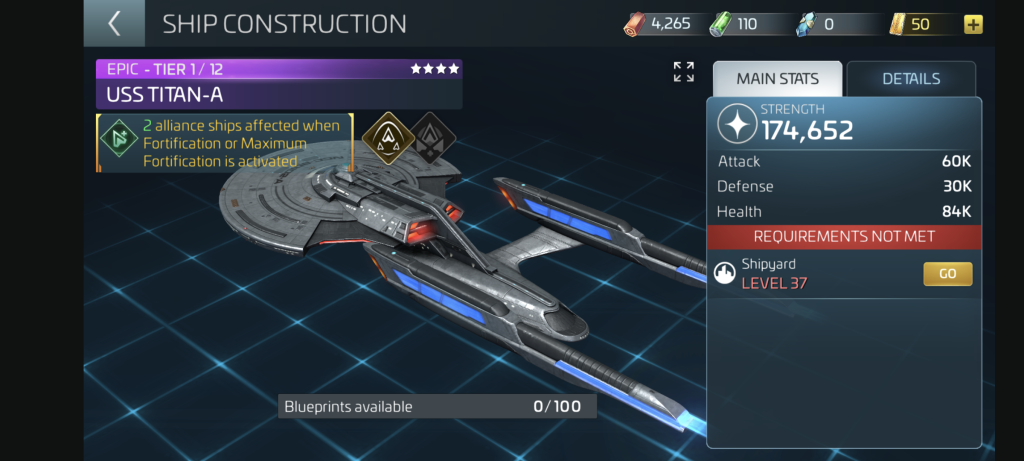
But all these increased stats, upgrades and new ships doesn’t help the gameplay of just choosing locations and going there. This is by far the most boring game I’ve ever played, and the only positive I can come up with are that the graphics are nice, especially the ship models. But even then, you can only get a good look at these in the menu as ships are a tiny dot when playing. These are nice enough that they could be ported to other games, with some nice alien ships, the USS Discovery, and the Titan-A.
You do get one reward for sticking with the game: at a certain milestone, your ship and station is marked for permanent PvP. This means that you’re now at the mercy of those who have played the game for longer and those that have paid money to upgrade their stuff. It’s very much a Pay 2 Win game so this is something that, if you can last through the boredom to reach it, will likely make many people stop playing.
This game is probably the most boring game I’ve ever experienced.
Stage 9
- Original Release: 2018
- Developer: Messy Desk
- Publisher: Messy Desk
- Platform: PC

Stage 9 was a very ambitious fan project: recreate the Enterprise D in its entirety to explore at your own leisure. The project was shut down by CBS before it was completed, so we only have a selection of areas to explore – although most major areas are covered, including some never seen in the show.
As this is a very early build, the optimisation isn’t great, so it will be sluggish on decent PCs. As it’s just exploring, it’s not an issue. NPCs look a bit freaky, but you can turn them off.
The Enterprise D interiors have been recreated in astounding detail, areas we never got to see – such as the stairs to the Observation lounge – are now something we can look at and inspect. Some consoles also have functionality, you can take control of the ship, play with cargo bay tractor beams and open shuttlebay doors.

Speaking of shuttlebays, the most impressive location in this is the Enterprise D’s main shuttlebay, which we never got to see in the show. It’s absolutely colossal, like a full size airport, and you can see why they never had the budget to create a set for it (and CGI was too early when the show was on the air). It really helps to sell the scale of the ship.
Another treat is the holodeck, which has more bridges to explore. There’s the bridge of the Enterprise form The Original Series along with different variants of the Enterprise D bridge from: the Encounter at Farpoint, Yesterday’s Enterprise, All Good Things and Generations, giving you a nice idea of how much they were changed for these episodes.
It is easy to get lost, though, and it seems obvious that a map would have been implemented later in development. You can find some neat extras such as a phaser range and a shuttle you can pilot.
It’s a massive shame that this project was shut down. The developers behind this made an officially approved interactive experience for The Orville where you get to explore the whole ship, and some of them are working on The Roddenberry Archive.
Star Trek: Galactic Enterprises
- Original Release: 2018
- Developer: Christophe Boelinger
- Publisher: WizKids
- Platform: Board game

A trading game where your goal is to make the most latinum. You all play as Ferengi as you bid on types of goods and try to sell them at the highest price. This isn’t a new game, though, it’s based on an older trading game called Fantasy Business.
Each round, one good is drawn for each player, plus one actions card. One of a time, players bid on these until each player has one card, or there are no cards left due to players passing. One glaring omission in the goods is that there are no self-sealing stembolts.
After this, each player writes down the price they want to sell at. The minimum price this could be is the base price, while the maximum is double the base price. Players can talk amongst themselves and come to agreements – however, they don’t have to honour those agreements when writing them down.
Once players have chosen their price, you go through each good. Anyone that set the highest price gets nothing, while everyone else gets their chosen price. The person that chose the lowest price also gets a bonus of 2 per card they own. If all players set the same, it counts as the lowest price and everyone gets the bonus.
After this, the goods are kept (they represent an ongoing supply) and you bid on new cards to add to your supply.
Your enjoyment of this game will depend entirely on how into negotiating everyone playing is, and how much they’re willing to screw each other over. Even then, there’s too much risk to setting the maximum price unless two people make a specific agreement, so most people just pick the maximum if they’re the only one with a good, then set the minimum if another person has it.
The original game has the same issues and nothing was every done to fix it in this version.
A Ferengi trading game sounds like a good idea. And while the cards and latinum look nice, this game just feels like accounting.
Star Trek Fluxx
- Original Release: 2018
- Developer: Looney Labs
- Publisher: Looney Labs
- Platform: Board game

The Fluxx games all play the same way, with just some minor differences. It’s a game of silly randomness and changing rules, and can be fun every now and then. I’ve owned a couple of version in the past, including Star Fluxx, which parodies multiple sci-fi shows and films. The game starts with you drawing one card and playing one card, but some cards change how much you draw and play in a turn.
Keeper cards are placed in front of you, these are usually characters of object. Goal cards will tell you which Keeper cards will win in game, but only one Goal is in play at once (although rules can change that). However, be wary about Creeper cards: these will join your Keepers when you draw them and you can’t win the game when you have one (unless that creeper is a specific goal). Action cards will also force swapping cards, let you draw and play more while surprise cards can stop actions or let you do something in their place.
The Star Trek version of Fluxx is based on The Original Series. One thing that this has that isn’t a standard part of “Fluxx” is the “Ungoal” card. If this comes out and every player has had the “Doomsday Machine” creeper and the Enterprise is not in play, everyone loses.
Star Trek: The Next Generation Fluxx
- Original Release: 2018
- Developer: Looney Labs
- Publisher: Looney Labs
- Platform: Board game
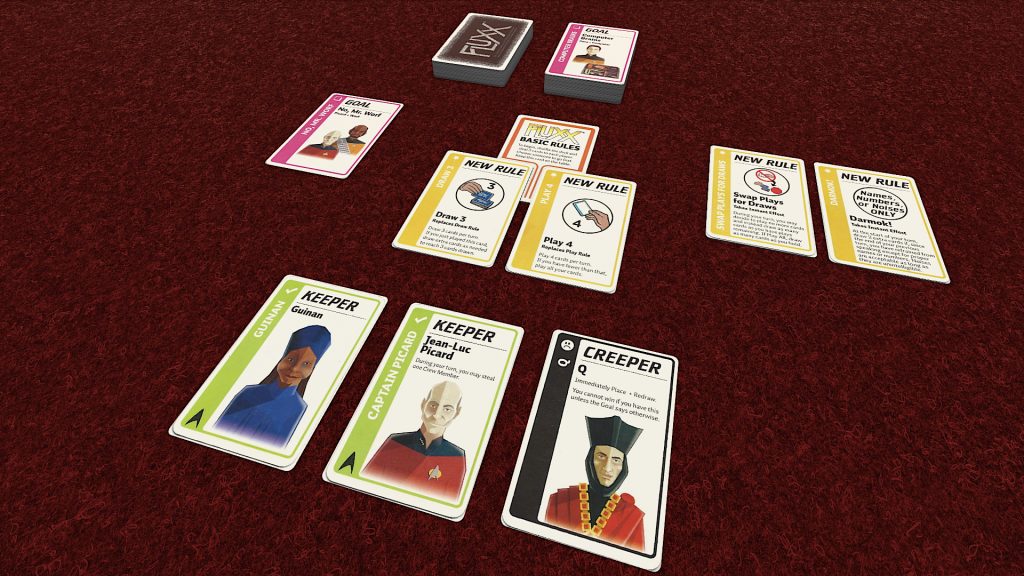
A version of Star Trek Fluxx for The Next Generation. This one is very similar, with another Ungoal card (this time with the Borg).
Alongside this was also the Bridge expansion, which adds new cards and goals for combining this with Star Trek Fluxx.
-
.png) 1
1
-
.png) 1
1
-
Star Trek Timelines
- Original Release: 2016
- Developer: Disruptor Beam/Tilting Point/Wicked Realm Games
- Publisher: Tilting Point
- Platform: Android, iOS, PC

For extremely long and grindy pay 2 win mobile games like this, I am playing until the inevitable brick wall. Most mobile games follow the same pattern: at the start, you’ll get lots of lootboxes thrown at you, you’ll get a bit of premium currency, and progression will be nice and swift to try and “hook” you. Then suddenly, progression stops. To get further, you’ll either need to grind for weeks, or pay money.
In Star Trek Timelines, there’s a random time anomaly messing with time to enable using characters and ships from all of the shows. It’s the go-to plot for Star Trek mobile games because it means more potential for selling stuff. Your mission is to fix the time anomalies, although with a game like this, there is never actually an “ending” as it means the game would be finished, so you know everything you do will fail.
I’ll start by talking about the good thing of Timelines. For starters, the graphics are really nice. Between missions, you get to see your ship in the planetary system the mission is set in, and they all look wonderful (if a bit busy). There’s nothing to actually do with this, it’s just a backdrop to look at, so it’s a bit frivolous and seems like a colossal waste of the nice assets.

Now I’ve finished talking about the good points, it’s on to the bad: this is barely a game. The main gameplay are away missions. Your crew have stats and you pick three for an away mission. You have “choices” in the mission but it just amounts to picking the person with the highest stat. You can’t use the same person on two actions in a row, so sometimes you have to pick the second best stat. That’s the total amount of thinking you use in the game. The writing is so dry and the use of just random versions of characters makes everything feel so unimportant that I found myself not having the energy to read most of the dialogue.
The game is all about collecting, and earning random things. Unless you spend a massive amount of time or money, you’re not going to be able to use the characters you like, it’s just whoever you happen to have. You need multiples of the same character to merge and you need to collect items (randomly) to improve their stats. I reached a point in mission 3 where I simply didn’t have the required stat. The way to continue is to play random old missions until you are randomly given something that will help. I managed to get 10 “premium” lootboxes which gave me a ton of characters…none of them useful. But don’t worry, you can buy specific crew at certain times by buying bundles that go up to £92!!!
I remember playing the beta of this and it had an in-depth combat system. It was a turn-based strategy that was a bit like rock-paper-scissors where your abilities worked against certain abilities, but made your ship vulnerable to others. This system was completely thrown out during the beta and replaced with one where you tap icons when they’ve finished charging. There’s so little thought involved that there’s an autoplay button along with an option to speed up the battles.
Timelines is definitely among the worst of all the Star Trek games. It’s devoid of anything interesting, there’s no gameplay and it’s just a chore repeatedly asking you to give it a ridiculous amount of money.
Star Trek: Ascendancy
- Original Release: 2016
- Developer: Aaron Dill, John Kovaleski, Sean Sweigart
- Publisher: Gale Force Nine
- Platform: Board Game

Star Trek Ascendancy is a game of exploration and conquest, although you can try to avoid the conquest if you want. Each player starts on their homeworld with a base that generates the three main resources (production, science and culture) as they explore the galaxy and eventually meet up, with the goal being destroying your rivals (which is not likely) or gaining 5 ascendancy tokens, which you get by generating and spending culture.
The exploration system in this is great: you roll a dice to determine how long the “space line” is then draw a new planet, which has an event. These discs can be moved around the connecting planet if needed (to account for table space and connecting to other planets), but are firmly locked in place one connected to a second planet. That said, it also has massive downsides as you can encounter threats and hazards. One player could get a bunch of safe systems ideal for colonising, while another player encounters pulsars and black holes which ruin ships and don’t provide any opportunity to expand or increase your production (although there are rule variants to help with this).
Another issue with the game is how long turns take. Sometimes I could have walked to the beach, had a stroll and still get back and have to wait a bit for my turn. I would have much preferred a system where you took turns doing single actions rather than conducting your entire turn in one go, or at least mechanics that allow for more reactions to what the current player is doing. The way Ascendancy works means games tend to drag on, while longer games like Twilight Imperium can keep you engaged the whole time.
While Ascendancy is fairly average for a 4X board game, the components and Star Trek them really improve it. Each faction has slightly different rules that reflect the species really well: the Federation can’t conquer neutral planets, for example, while the Cardassians need to have forces by a planet for them to produce anything and playing as the Ferengi does feel like you are merchants. It elevates the game from an average one to one that, despite its flaws, is still fun if everyone is into Star Trek.
Star Trek: Frontiers
- Original Release: 2015
- Developer: Vlaada Chvátil, Andrew Parks
- Publisher: WizKids
- Platform: Board Game
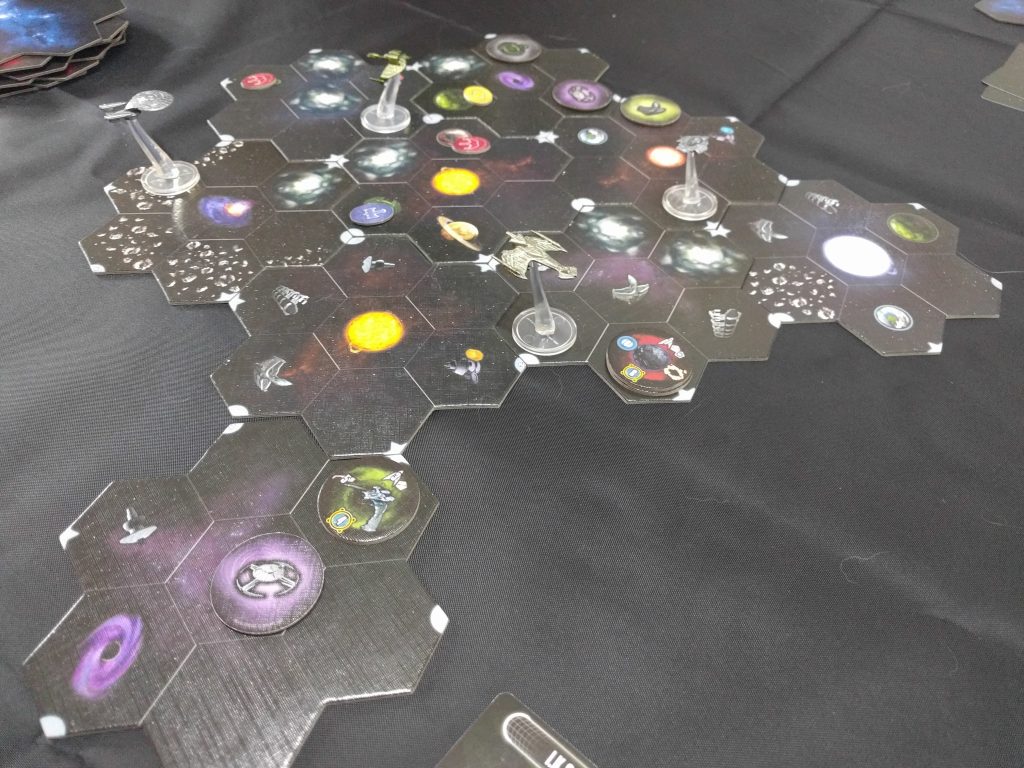
Star Trek: Frontiers is a Star Trek version of the popular board game Mage Knight. It focuses on exploration of the Gamma Quadrant (although you fight a lot of Romulans and Borg). It’s suitable for up to four players, who pick between Picard on the Enterprise D, Sisko on the Definat, Lursa and B’etor on a Bird of Prey and Markok on a Negh’var.
It can be played co-op or competitively (although you still have to complete objectives. The game is very in depth with a lot of complicated rules, which means a lot of checking to see how different abilities interact. That said, all parts of the game are engaging, even if it’s a lot to wrap your head around. There’s a big list of scenarios to choose from, and the good combat mechanics (while you explore, it’s very much combat focused) are well thought out.
Frontiers also got an expansion. In following on from the Enterprise D and Defiant, it added a new playable ship: The Enterprise A. Along with a new opponent: Khan, flying in his Dominion Warship. The designer was clearly a Wrath of Khan fan and went with that even though there was still plenty of TNG era ships, such as Voyager, or other races.
Star Trek: Panic
- Original Release: 2015
- Developer: Justin De Witt
- Publisher: Fireside Games
- Platform: Board Game

Star Trek Panic is a Star Trek version of a popular co-op tower defence board game called Castle Panic. In Castle Panic, you defend a castle while enemies stream from all around you, you have to use your cards to repair your castle walls and defeat the advancing enemies.
Star Trek Panic isn’t simply a retheme of Castle Panic, but brings about new mechanics that suit the theme perfectly. For starters, the Enterprise is not stationary, so you can spin the ship to face your powered shields towards the enemies. You can also move forward, which is simulated not by moving the Enterprise model, but by moving the enemy ships in front of the Enterprise closet (although ships behind the Enterprise don’t move further away). This is important for another main element: the missions.
Your objective isn’t just to withstand an attack, but to complete missions along the way. Each mission is only active for a number of turns and require spending cards to fix problems or moving the Enterprise into unknown ships to investigate. This creates the choice of using cards to defend the Enterprise or to finish the mission to get closer to winning the game. As enemies attack, they’ll first damage shields, then hurt the section of Enterprise relevant to that location: you have cardboard overlays to stick on top of the cardboard Enterprise to show off the damage, and it looks really nice.
Star Trek Panic is a really nice version of an already great board game, with the new additions fitting the Star Trek theme really well. Unfortunately, the physical game never got released in the UK.
Risk: Star Trek 50th Anniversary Edition
- Original Release: 2015
- Developer: The Op
- Publisher: The Op
- Platform: Board Game

Like Monopoly, Risk is another game that has many, many different licensed versions. However, Risk changes things more than Monopoly does, and the most basic licensed versions have a different map, while some versions have their own rules and can even be completely unique games with the Risk branding thrown on for sales.
Risk: Star Trek has two ways to play: One that’s just Risk and another which adds more to it. You play as different captains from the shows (Q has pitted them all against each other, and for some reason they’re going along with it and not working out a way to cooperate). In the enhanced version of the game, you have to complete missions such as “conquer locations controlled by 2 different opponents”, “control the United Federation of Planets” and “Use abilities of all your crew in one turn”. Due to the nature of these missions, the game length can vary a lot – it can either take forever, or it can be over in three turns.
The main gameplay is just like risk: sent troops to nearby locations, fight if there opponents or neutral aliens there. This is done by rolling dice, one for each ship attacking or defending (with a maximum of 3 dice for the attacker and 2 for the defender). You can move some of your ships at the end of your turn.
At the start of each turn, you have to turn over a Q card, which causes random events, these can help you out or make you lose things, some impact the whole board. The most significant one is the Tribbles, which have two starting cards. These work similar to Pandemic where they’ll grow in numbers before multiplying to other locations. There are only 50 tribbles included in the game, and if you place all of them on the board….everyone loses.
Risk: Star Trek is an interesting take on Risk, although one that’s extremely random.
Star Trek: The Dice Game
- Original Release: 2016
- Developer: Carl White
- Publisher: Self-Published
- Platform: Board Game

This is a fan-made board game, but has really nice assets and is the most popular fan made Star Trek board game, other than Klin Zha. It heavily borrows elements from a solo board game I enjoyed a lot called Deep Space D-6.
This is a solo board game where you have to use dice to get your ship though missions and dangers. Each turn, you’ll roll the dice – which represent crew divisions and assign them to tasks to manage your ship or contribute to completing missions. One of the dice is a “threat”, which get placed on the threat meter. One you have four on here, you’ll draw an extra event.
The events can damage your ship, put crew out of commission or will stop you form performing certain actions until you complete them by assigning dice to them. It’s a really fun game and the mission structure of it makes it different enough from the original game that it’s nice to play both. The developer did get approached by multiple publishers, who pitched the game to Paramount, but never got a response.
Star Trek: Bridge Crew
- Original Release: 2017
- Developer: Red Storm
- Publisher: Ubisoft
- Platform: PS4, PC

Bridge Crew was originally released as a VR exclusive, before being patched to allow people to play it without VR. The ideal experience is to play this in VR with motion controllers with three other friends playing it in VR with motion controllers. I have played this with friends, but the VR is way beyond my budget.
The game itself borrows heavily from Artemis Spaceship Bridge Simulator, a LAN game where you essentially create a starship in your house, with each person having a PC to represent their station (or the viewscreen for the captain). I’ve played it at a convention and it’s a great experience, and Bridge Crew is the closest thing that can be done online.
There are four stations in this game: Captain, Helm, Tactical and Engineering. Captain is the simplest role in multiplayer: you get told the orders to pass on to your crew, answer hails and push the red alert button. Most of this role is via the voice chat, giving commands to your crew (and hoping they pay attention).
Helm gets to fly the ship and set warp and “impulse” destinations (what the game calls in-system warp), and is probably the most involved position due to this.
Tactical gets to control the phaser and shield. There’s no phaser arcs or shield arcs, so unfortunately the combat is very basic. You can disrupt enemy weapons, shields or engines via hacking.
Engineering sets power levels and prioritises repairs, this is probably the worst role to have and you don’t even get a clear idea of what is happening due to not having access to sensor data like the other three roles.
In singleplayer, you play as the captain but can give orders to the crew. The AI is very basic and some actions can reset other orders. The helm officer won’t avoid obstacles, so for some situations, you can take over the station and control it directly (although you can’t give orders from there, you have to return to the Captain’s position). It’s not the ideal way to play, but it gets the job done and is far better than not having the option.
The main (and incredibly short) 6-mission story takes place on the USS Aegis, a ship from the Kelvin timeline. The bridge itself is wonderfully made and fits the aesthetic while adapting it to work for a game like this. The missions are fine, but after this all that’s left is random missions. There’s not a lot of content in this game.
The game does include additional ships you can use in the random missions: the prime timeline original TOS-style Enterprise and (as part of DLC) the Enterprise D. The TOS bridge absolutely looks the part and is very authentic, although you definitely need to use the help overlay to work out which buttons do what. It’s difficult to use, but it gets the feel of being in The Original Series really well.
The Enterprise D bridge takes a few more liberties in its interface, mainly making the LCARS displays more game-like to help it play a lot better. This also makes the engineer’s job (renamed as “operations”) better by improving the repair side of things by assigning damage teams.
Bridge Crew is a great start for a multiplayer Star Trek game, but would have been nice with more in depth gameplay for weapons and shields, as well as far more structured missions.
Star Trek: Discovery: Away Mission
- Original Release: 2018
- Developer: Sandbox VR
- Publisher: Sandbox VR
- Platform: VR Experience
- Not played: Cost of getting to location and playing too expensive.

Star Trek: Discovery: Away Mission is a full body VR room experience. This means you need to go to one of the company’s locations, gear up in their motion sensing outfits and get set up in their special rooms – sort of like an actual Holodeck. Six people can play the game, with you all in the same room – their location in the room corresponds with their location in the game, so you can move around them as needed.
The rooms also use fans and other features to enhance the experience – for example, the suit’s rumble packs combined with the fans in the room are used to create the sense of using the transporter. It sounds like a fascinating experience.
In Away Mission, you play as a member of Starfleet on board the USS Discovery, investigating a lost Starfleet ship. Tilly acts as your guide from the mission (from Discovery). The mission involves a lot of combat, but you also get points based on how well you use your tricorder.
-
.png) 1
1
-
Star Trek: The Next Generation – On Board the USS Enterprise
- Original Release: 2013
- Developer: Carlton Books
- Publisher: Carlton Books
- Platform: PC
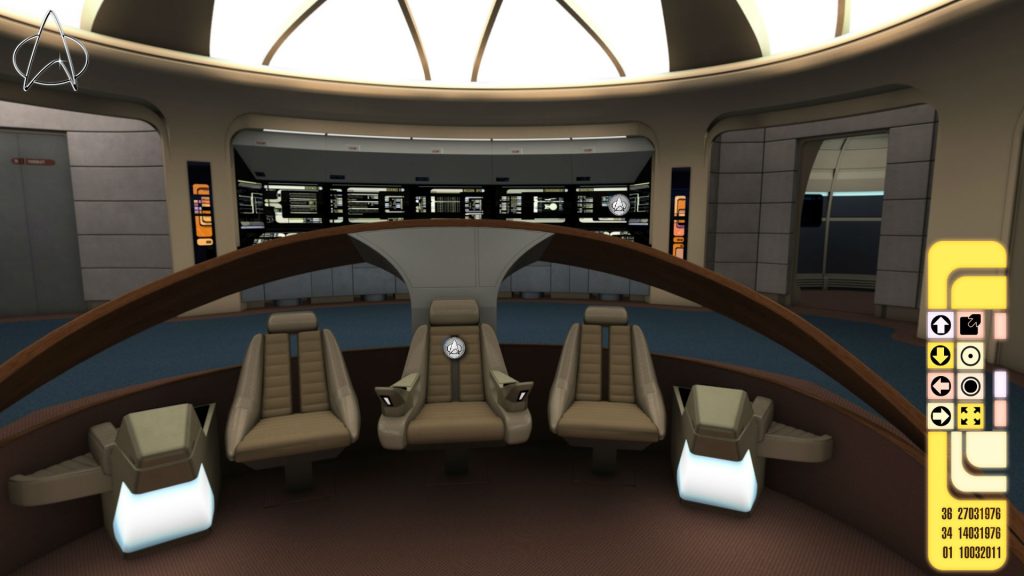
This reference CD came with the book Star Trek: The Next Generation: On Board The Enterprise, written by Denise and Michael Okuda. It doesn’t mention who made the CD that came with it. The book mentions a “Breathtaking 3D Interactive Tour” which definitely oversells it. You may have noticed from the screenshot that the rooms you look at are computer generated renders. While these renders are extremely well detailed, you can’t explore them in 3D, you’re just looking at photos of the renders. Each room has a couple of 360 photos to scroll through and nothing to interact with, it’s a very limited tour.
Included in this is the Bridge, Captain’s Ready Room, the Transporter Room, Sick Bay, a corridor, Engineering and a cargo bay. With how detailed each location is, and how it was all created on a computer, it’s surprising that there are so few places to view from, as it’s much easier to create a new render with this than taking photos of the actual sets, as done in the Interactive Technical Manual.
Star Trek: Attack Wing
- Original Release: 2013
- Developer: Christopher Guild, Andrew Parks
- Publisher: WizKids
- Platform: Board Game

Star Trek: Attack Wing is the main miniature-based Star Trek game, and is sort of still going now, although mainly in the form of repackaged sets. From what I can tell, the last new ship was a Xindi-Reptillian ship in 2017, with the game also being used as a basis for a new co-op version called Star Trek Alliance.
Attack Wing does a good job at representing ship combat in Star Trek without being overly complex (although if you star incorporating many different sets, cards start overruling and contradicting each other). Each round, you both set your planned ship manoeuvre on a dial, then move on to using abilities and attacking. Not only is your ship important, but many special abilities and actions are provided by the crew you have.
There’s a lot of strategy in the game. One example is how you use shields. Some abilities require shield usage, so you have the ability to allow a shot to bypass your shield in order to protect your shield in order to use that ability. You’re also constantly moving and circling each other.
There are also a ton of missions you can get for the game, and some colossal Borg ships you can use (including one with pop out sphere). It’s a fun game and can be scaled and made more complex, or kept to a simple game with a couple of ships.
I also want to point out the superb Tabletop Simulator version, which spawn ships/cards based on fleets you design online, and also has a ton of features to help you out, such as control cards that make the ships move automatically.
Star Trek Trexels
- Original Release: 2013
- Developer: Xcube Games
- Publisher: YesGnome, LLC
- Platform: Android, iOS

This is a game that required server access to run: one of a few Star Trek games that are now unplayable due to this. I did play Trexels when it first came out, though, although I wasn’t very impressed.
After seeing Star Wars take on this formula with Tiny Death Star (which was actually good), this is Star Trek’s take on the pixelated room management game that was popular at the time. Unfortunately, greed took over on this and the game was excruciatingly slow unless you paid for premium currency. You could gain it from completing missions, but it was very slow.
The missions were extremely dull, too. Your crew generated energy cubes over time, so you had to wait for your energy to build up and press one of the two actions at the bottom of the screen. Rooms would increase this energy, as well as other resources needed. Building up a starship really could have been a lot of fun – especially as similar games have shown it can work – but Trexels missed the mark.
Star Trek: Alien Domain
- Original Release: 2015
- Developer: GameSamba
- Publisher: GameSamba
- Platform: Browser
- Not played: Servers shut down

Star Trek: Alien Domain was a browser-based MMO that had a focus on base building and resource management. It got an expansion/update in 2019 with Incursion before being shut down in 2022. Due to this, there is no way to play the game.
The game looks like a free to play game where it start off giving you lots of stuff, but then turns into a slow, hopeless grind unless you spend a ton of money to keep up with everything. The designs of everything look a bit off to me, but I can’t quite put my finger on why.
Star Trek: Wrath of Gems
- Original Release: 2015
- Developer: Genera
- Publisher: CBS Interactive
- Platform: Browser
- Not played: Servers shut down
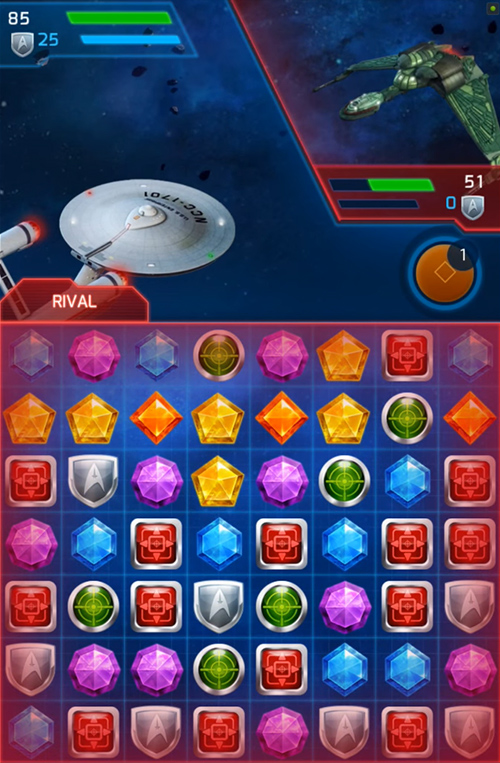
After Trexels, Star Trek needed to jump straight on the next mobile gaming fad. Following on from the success of Candy Crush, Wrath of Gems is another Bejewelled clone that has some Star Trek flair stuck onto it.
You play by swapping the location of two gems in order to create matching groups of 3 or more. In basic Bejewelled gameplay, you’re doing this to get points, but Wrath of Gems adds a few spins on it. In ship combat, attack gems will let you shoot at your opponents with shields restoring health. You and your opponent take turns, so you have to be careful not to give your opponent a great move. Another type involves collecting combos of different types of gems, while another one is on ground missions where gems unlock your crew’s attacks.
There’s a TOS story and TNG story, and each settings has ships and crew to unlock and upgrade, using currency collected from various moves (or purchased). These can also be spent on lootboxes (which can also be purchased), giving you upgraded abilities.
The servers for this went down sometime in 2018 and as a result, it is not impossible to play the game, even if you have it installed.
Star Trek: Five-Year Mission
- Original Release: 2015
- Developer: David E. Whitcher
- Publisher: Mayfair Games
- Platform: Board Game

Star Trek: Five-Year Mission is a co-op dice game that uses mechanics from a simple dice game called “Roll for It” – which incidentally was a game I bought because of Wil Wheton’s TableTop show.
There are three decks of “alerts” in increasing difficulty, these have dice values and colours that need to be placed on it to complete. If you draw too many of these, you fail, and a new one is drawn at the start of each person’s turn – to make matters work, some may cause you to draw another of the next difficulty up, so you can end up with three new challenges at the start of your turn.
A turn sequence is simple: draw a new alert, collect dice (up to your maximum of 5), roll the new dice (plus any you want from last turn) and place them on the alerts to complete them.
Some of these alerts will grant you powers that can alter dice values or colours, but this dice manipulation is few and far between. With a bit more, there could have been some strategy to this, but most of the game you’re just rolling and placing dice without needing to plan or think. It’s a fun game, but a bit too simple at times.
One nice thing about the game is that you can play with either a TOS theme or TNG theme, or mix them together.
Star Trek Road Trip
- Original Release: 2015
- Developer: Tyler Brown, Mikel Fromstein
- Publisher: Aquarius
- Platform: Board Game
- Not played

Road Trip is a series of basic roll and move board games. You have to collect attack tokens in order to progress, with action and 50/50 cards giving you bonuses or making it worse for you. The goal is to get a toll pass to reach the centre of the board, fight the battled in the four corners then return back.
The Road Trip games are based on different franchises, all with the exact same board layout, rules and card results (just with different designs, names and flavour text). It sounds like a very generic and boring game.
-
.png) 2
2
-
Monopoly: Klingon Edition
- Original Release: 2011
- Developer: Hasbro
- Publisher: Hasbro
- Platform: Board Game
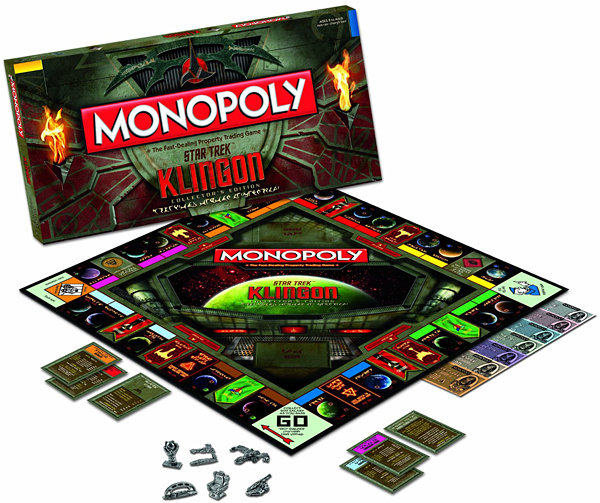
While this is still the exact same game as regular Monopoly, there’s a bit of effort put into the design of this. Every single part of the game has been translated into Klingon and the overall design is extremely nice – apart from the four corner tiles that Hasbro never like to change (although they still approved Klingon translations on them). Things have also been reworded to make it sound like a war game – money represents the size of your forces. It doesn’t make any difference to how the game works, but it does add a bit of charm to this version. It’s still an awful game.
Star Trek Infinite Space
- Original Release: Cancelled 2011
- Developer: Gamefound
- Publisher: None
- Platform: Browser
- Not played: No playable builds available

Infinite Space was described as a casual browser-based MMO. While it was in development, the studio Gamefound were still looking for a publishing partner, but had to cancel the game when nobody was interested in it.
The game looked very combat heavy, although some footage showed the player character walking around the starbase. There was an ability bar at the bottom with lots of different powers.
Players would have been able to play as the Federation or Klingons, with pirates and Cardassians also acting as enemies. Federation ships included an Intrepid, Galaxy, Steamrunner and Norway.
Star Trek: Catan
- Original Release: 2012
- Developer: Klaus Teuber
- Publisher: Catan Studio
- Platform: Board Game

Catan is a game that is essentially decided by the initial placement of your settlements. Each round, you roll a dice and those tiles product resources to anyone with an settlement next to them. These can be traded with other players and used to build routes, more settlements and cities. It has an importance in board games as one of the games that made modern board games popular, but I really don’t like it at all.
The Star Trek version of Catan is the same game. The resources are not different planets, which don’t really do a good job at portraying what you get from them. The different resources are: Tritanium, Food, Oxygen, Dilithium and Water. Routes are depicted by ships, outpost and starbases represent settlements and cities. The klingon ship is the robber, which stops production on a tile and can be moved on a roll of 7.
The only difference in this version are “Support Cards”. These cards help with the actions in the game, and once you use one it can be swapped with another. It’s a very small change.

This version of Catan did get an expansion, called Federation Space, which provides two boards with maps to play on instead of the hexagon tiles. You also now play as different species, although all you have to represent this is a scoreboard with numbers in the design of that species. The ships are still Constitution class ships.
Apart from having some victory point markets on the board (the first person that reaches them collects it), it plays the same as regular Catan.
Star Trek Deck Building Game: The Original Series
- Original Release: 2012
- Developer: Alex Bykov
- Publisher: Bandai
- Platform: Board Game

This is essentially just a version of Star Trek Deck Building Game: The Next Generation with a theme of The Original Series. It’s a slightly simplified version, with the main difference being the lack of starships to fight – which also means you can’t upgrade your base ship.
Star Trek HeroClix: Tactics
- Original Release: 2012
- Developer: Seth Johnson
- Publisher: WizKids
- Platform: Board Game

HeroClix is a minauture combat system designed for superhero games. It was very well liked and went into many different properties.
When it moved onto Star Trek, it used ships as the models, but the gameplay was not changed to make it feel any different, it still felt like a superhero game.
Star Trek (2013)
- Original Release: 2013
- Developer: Digital Extremes
- Publisher: Namco Bandai
- Platform: Xbox 360, PS3, PC

Based on the Kelvin Timeline introduced in the 2009 “reboot” film, this is a new adventure starring the crew of the films, with the film’s actors providing voice work. The game is focused on co-op, letting you and a friend play as Kirk and Spock (although you can play singleplayer with the computer handling the other character).
The game is very clearly unfinished, it’s quite buggy with very wonky animations. Luckily, my latest playthrough I only encountered a couple of times where the glitches caused Spock to die, most of it was just odd visual bugs, such as within the first minute where Kirk span around in a circle and hovered up above the bridge.
Despite this clunkiness, I can’t bring myself to hate this game, I really enjoy it a lot. The dialogue between Kirk and Spock keep things moving and the game tries to keep itself fresh with different environments (they do a great job with the “giant industrial brewery” style of the Enterprise interior) and action pieces like skydiving. The combat is quite simple, but entertaining, with a focus on stealth and finding hidden tunnels and vents to sneak into positions to hack turrets.
The plot follows an attack on New Vulcan, where Gorn from another alternate universe have invaded to take a powerful device the Vulcans were working on. These Gorn are very different and you’ll encounter different types with strength and abilities to provide variety of enemies. The Gorn also have a virus that can turn your own crew against you, and the game heavily suggests stunning them instead of killing them – various sections have bonus objectives such as non-lethal or stealth to gain extra XP.
Shooting is a fairly generic cover shooter. I found myself using stun (which only makes enemies dizzy) then punching them to knock them out. There are various weapons to try, but the trusty phaser is usually enough. Some sections encourage stealth, but this is always optional. There are turrets, cameras and doors to hack using simple minigames, and is always risky trying in combat.
While this Star Trek game doesn’t really excel at any particular thing, it’s still a very enjoyable romp with a good story and fun action.
Star Trek: Rivals
- Original Release: 2013
- Developer: Elephant Mouse
- Publisher: Elephant Mouse
- Platform: iOS
- Not Played: Servers offline, although I have played the game it is based on.

Star Trek Rivals is a simple card game using images from Star Trek 09. Each card has a number on each side. You and your opponent take turns placing one of your five cards in a 3×3 grin. The aim is to place the card down in a way so that the numbers on your card face a lower number on an opponent’s card, you get 1 point each time you do this.
The idea for this game wasn’t made for this, though. This is a rip-off of a minigame called Triple Triad that originated from Final Fantasy VIII (and has been in multiple games since), so I played one of those to give the game a go. It’s a simple game, but can be fun. Competing against someone who had paid for better cards probably isn’t fun, though.
-
.png) 1
1
-
.png) 1
1
-
Star Trek: Cadet Training Facility
- Original Release: 2009
- Developer: Nokia/Verizon
- Publisher: Nokia/Verizon
- Platform: Browser

This Star Trek 09 promotional flash game was made in conjunction with Nokia and Verizon, it consisted of four minigames: Engineering Simulator, Weapons Simulator, Helm Simulator and Captain’s Test (although Captain’s Test doesn’t work).
Engineering Simulator has you fixing the warp core by unscrambling images from the film in a sliding block puzzle format.
In Weapons Simulator, a comet has hit a planet and you have to blast the debris caused by it, shooting your way though five rounds.
In Helm Simulator, a ship has come though a wormhole (strangely, a Defiant Class ship, not a design used in the film). You automatically fly towards it and have to dodge asteroids and hit glowy things to get propelled forwards.
It’s a fairly basic minigame collection, trying to get you to watch the film and buy an old school flip phone.
Star Trek: Academy Trainer
- Original Release: 2009
- Developer: AddictingGames
- Publisher: Paramount
- Platform: Browser

This is a minigame collection that supposedly tests what cadets need to do at Starfleet Academy, including some extremely difficult spot the difference puzzles which will end up costing you a lot of points.
It starts off with a game where you have to match the colours of wires, then spot the difference, then you have to click to stop pulsating bars at the right position. Next is a maze where you have to move an “unstable atom” by dragging discs across the screen, followed by a terrible breakout/Arkanoid clone. Then some simple maths, more spot the difference, the memory game pairs and finally a shooting game where you blow up lots of glowing discs.
It’s a pretty bad minigame collection.
Scene It? Star Trek
- Original Release: 2009
- Developer: Mattel
- Publisher: Mattel
- Platform: Board Game

The Scene It? series of trivia games mixes question cards with visual quizzes via a DVD included with the package. They all follow the same rules.
On your turn, you roll the two dice. One shows how many spaces you use, the second shows which category you need to answer a question for. If you get the answer correct, you’ll get to take another turn.
Two of the categories, MyPlay and AllPlay, involve the DVD. MyPlay shows you clips form the shows and movies then asks you a question about it, while AllPlay has a voice clip or a distorted image and all players can answer, the quickest will get to take the next turn.
Once you reach the end of the board, you have to answer three questions right before answering one final AllPlay question.
The Scene it? franchise is kind of fascinating, as it seems like it was heavily marketed as something to buy as a gift. I think it says a lot that it’s easier and cheaper to buy a sealed copy of this game than it is a used one.
That said, I am surprised that nobody has made a quiz-like game in the style of Jackbox where people use their phones to answer questions. You could have some basic categories while selling licensed packs as DLC. It would have a lot less setup time, people can play while relaxing on a sofa and it could potentially allow a mix of questions or even assign themes to different people, so you don’t need everyone to know one franchise really well.
Monopoly: Star Trek Continuum Edition
- Original Release: 2009
- Developer: Hasbro
- Publisher: Hasbro
- Platform: Board Game

The third Star Trek Monopoly game, covering all shows up to Enterprise. This doesn’t have the wormhole mechanic from The Next Generation Monopoly, and even just includes the basic house/hotel pieces from monopoly instead of custom ones.
Star Trek Scrabble
- Original Release: 2009
- Developer: Fudex
- Publisher: Fundex
- Platform: Board Game

This version of Scabble can just be played on a regular Scrabble board. The tile distribution and board layout are exactly the same as regular scrabble (except that the Triple Word Score spaces are now called Tribble Word Score, but still triples your store). What makes this different is that it comes with a list of 79 words that can be played for additional points. KYLE, PIKE and EKOS will get you 5 extra points, BAILEY, EYMORG and PONFARR get you 10 points while SCOTTY, ANDORIA and BONES will get you 20 points. On top of this, if you play any word from The Klingon Dictionary, you get 15 points.
Star Trek Online
- Original Release: 2010
- Developer: Cryptic Studios
- Publisher: Atari, Perfect World, Gearbox
- Platform: PC, Xbox One/Series, PlayStation 4/5.

I’ve played a lot of Star Trek Online in the past, so for this playthough I decided to start from scratch on Xbox. The game is still evolving with gameplay changes and new content, so my thought here are based on my original time with the game from a while ago on PC, along with finishing up to the end of the Delta Quadrant on Xbox.
The gameplay for this game is best described as “serviceable”. It’s not terrible, but it also isn’t the most exciting. It gets the job done and is just about entertaining enough to get you to the next part of the game. In space combat, you have to keep an eye on shield arcs and weapon charge while activating powers, while on the ground it plays a bit more like a shooter, but doesn’t have exact aiming (you can also play as a more traditional MMO game on PC).
The main enjoyment I got from the game was the story, having a few dialogue choices (even though they change nothing) and just interreacting with the world. The overall story arc is about a mysterious threat pushing people into war and being discovered before everyone starts banding together to investigate and stop them. Early on, voiced dialogue was rare, but is not much more common, although some missions have sections where the dialogue is just text, which creates an odd mixture of the two. There are lots of references and a lot of characters from the shows crop up, usually voiced by the same actor.

The mission lengths vary a massive amount, and you really have no idea how long a mission will be before starting it. Some just involve talking to one person while others can be a few hours long. Some can be just combat after combat (sometimes massively overstaying its welcome as wave after wave of enemies turn up) while others are more story based with lots of information to reveal, characters to interact with and puzzles to solve – these ones are worth playing the game for.
At certain ranks you get awarded a ship, you can pick a name and registry. I decided to call all mine the USS Saru, adding letters as I got new ships. You only have a choice between a few ships, while the rest you’ll have to grind by collecting dilithium or pay for with their premium currency of “Zen” – there are a lot of different currencies in the game, which kind of goes against Star Trek a lot. By the end of my playthough, I had enough dilithium for one ship.
What is nice about the ships is that you can customise them, choosing different hulls, saucers, pylons and nacelles, as well as some hull designs. Some options are locked behind premium currency, though. I ended up changing all of my ships. I would absolutely love a new game similar to Starship Creator that just let you design ships using all of the options available in Star Trek Online.
There’s plenty of Star Trek Online that I didn’t such, such as the group activities. I do remember doing a few missions in he past, including one where you fly through a massive Voth ships that is so large that it has multiple hangar bays that carry Voth city ships. There’s other kind of repeatable missions to help grind for upgrades, which is something I really don’t enjoy.
I enjoyed my time with Star Trek Online, but at towards the end of the Delta Quadrant missions I felt extremely underpowered (while up until a few missions prior, I felt overpowered) and even buying a new ship didn’t help much. I think I had reached the point of grinding or coughing up money.
You can choose not only different factions in the game (although later missions mostly are the same for all), but different introductions. A major one is the New Romulus faction, who can then join the Federation or Klingons after their starting missions. I tried out the Discovery era missions (you end up forward in time to carry on with the main campaign) and enjoyed it, you get to interact with Lorca. The tutorial mission is just a slightly reworked version of the normal tutorial, but at least you get to meet captain Shran. The ship you use also has one of the nicest bridges in the game (the ship interiors are terrible for the most part). I do appreciate that you essentially get to play a short Discovery game.
I don’t think I will return to Star Trek Online, though, due to the game’s economy and grinding. Once development for the game slows down, I would certainly be very interested in a one-off purchase “Star Trek Offline”.
Star Trek Online Architect
- Original Release: 2010
- Developer: The Game Agency
- Publisher: Atari
- Platform: Browser
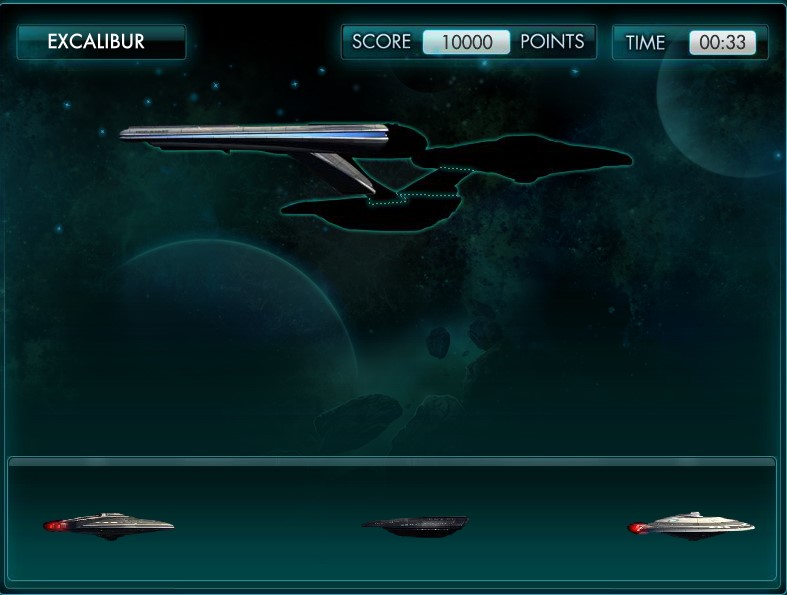
This was a flash browser game made to promote Star Trek Online. I initially thought that this was a lost game, until someone kindly pointed me to Newgrounds, where it’s listed under the name “Star Trek Ship Builder”.
The game is deceptively simple: an outline of ship parts will appear and components will scroll past quite fast. You need to drag the right ones to the main screen. The better you do, the more time and points you gain. It’s surprisingly difficult but simple fun.
Star Trek: Fleet Captains
- Original Release: 2011
- Developer: Mike Elliott, Bryan Kinsella, Ethan Pasternack
- Publisher: WizKids
- Platform: Board Game

One of the big Star Trek board games. This came with 24 miniatures, a ton of cards and is quite an in-depth game. There’s a focus on both exploration and combat, with the board starting out as completely hidden. It’s a 1v1 game (although you can play as 2v2).
Setup takes a bit of time, sorting out the map. You don’t get to choose your initial ships, instead you draw them at random until you have 10 points (or an agreed amount). Mission types are based on the ships drawn. You then pick four decks of cards to become your abilities for that game.
When you reach a new tile, there’s a random chance of an encounter, which you draw from the encounter deck. These will usually be challenges you have to face by the ship’s abilities – which can be altered by twisting the base – cards, and crew assigned to the ship. Checks involves adding these abilities and rolling the dice. While this is all a bit random it’s a lot of fun, but I feel it doesn’t suit the 1v1 nature of this game.
Combat also uses this system, pitting your ship’s weapons stat against the opponent’s shield stat (with dice rolls added). Destroying enemy ships nets you a victory point, but the opponent can draw a new ship and their fleet strength goes up as well. Your focus will be on completing missions instead, creating a lot of variety in how you play.
There’s a lot of good things about Fleet Captains, but for me the weakest aspect is the 1v1 or 2v2 nature of it mixed with the randomness. I personally think this would work better as a co-op game.
Star Trek: Expeditions
- Original Release: 2011
- Developer: Reiner Knizia
- Publisher: WizKids
- Platform: Board Game

I remember playing this a while ago (but unfortunately didn’t take any pictures of it), and the main reason I remember it was because it was so dull. It’s a co-op board game where you’re working together to fix three things on a planet: stop a civil war, stop the Klingons in orbit and convince the planet to join the Federation. Most turns involve flipping a random event, moving your characters and completing random missions by rolling a dice and adding the character’s bonus to it.
Everything about the game is just so dry: the board itself is boring, and the backs of the card are needlessly busy while dull at the same time, making the start of the game look like the mess. The flavour text on the cards is boring, or sometimes doesn’t exist – one of the random events is just “transporter’s don’t work this turn”.
This kind of game can be done well – there’s a brilliant Thunderbirds game that is similar but so much more fun.
Star Trek Deck Building Game: The Next Generation
- Original Release: 2011
- Developer: Alex Bykov
- Publisher: Bandai
- Platform: Board Game

Another board game I remember playing, that is also already in Tabletop Simulator. The only photo I originally took was of the “Phasers” card, some of you may spot why I found that particular card noticeable.
This is a deckbuilding game, not to be confused with Collectable/Trading Card Games where you build decks before the game, in this everyone starts with the same cards and purchases new cards from the middle of the table. You’ll draw 5 cards, use them in a turn, draw 5 more. When your deck runs out, you shuffle your discard pile to make a new deck. It’s a great mechanic used in a lot of games.
Most cards will give you XP which is sued to buy other cards. One thing that is more unique about this deck builder is that you have a flagship. Some of your cards will increase the ability of your flagship – with the goal of defeating ships from the space deck by battling them or via diplomacy (where you can use it as your new flagship). You can also battle other players, but I found it unrewarding and a pain.
It’s a really fun card game, and even has extra scenarios to play it in co-op against the Borg, or dealing with a Klingon Civil War.
-
.png) 1
1
-
.png) 1
1
All Bond Games
in General Gaming Discussion
Posted
The Spy Who Loved Me
The Spy Who Loved Me is a vehicle-based combat game, with a few extra parts to mix things up. The levels vary as the game progresses. For this one, I ended up playing the Atari ST version over the Amiga version, as the emulator I used for the Amiga didn’t like it.
The first two levels have similar gameplay. You drive upwards, dodging enemies, shooting them and collecting Q coins. There are civilians hanging out on the road, and you’ll lose points for hitting them – but squishing them is so satisfying and the best part of the game that I did it anyway.
The first level transitions from a car to a boat (the gameplay doesn’t change) and finishes once you stop at the end. The second is a looping track – you need to collect enough Q coins to purchase a submarine upgrade to finish the level. The big flaw with these levels are that, even though you can go fast, it’s much more beneficial to go slow – enemies eliminate your easily if you travel by speed, and going slower helps avoid obstacles and collect coins.
The third level turns the game into an extremely tough vertical scrolling shooter. Power ups float down from the top of the screen and you’ll need some upgrades to stand a chance against the level’s boss.
Next is a short lightgun-style level. The screen doesn’t move, just shoot people until you make it through the enemies.
Next up is a codebreaker, like the Mastermind board game. This level is also a form of copy protection – you need to enter coordinates from the game’s manual to proceed.
The final level is a Jetski level, it plays similar to the first two, but more focus on shooting than dodging obstacles.
The final part is another lightgun-style section, shoot some enemies, and then jaws to beat the game.
The vehicles section might have been fun if enemies weren’t bullet sponges and dealt so much damage, while the others sections are just tedious. This is Domark’s last James Bond film tie-in, so they went out on a low note.
Other Versions
Commodore Amiga
This is identical to the Atari ST version.
MS-DOS
This version definitely released, but I can’t find the ROM or even any screenshots online. Not only did this version sell poorly, but was so bad that it had many returns. The copies were recycled into blank floppy discs.
Commodore 64
On top of simpler graphics, this version only has the four vehicle levels. The shooting and codebreaker parts have been removed. These parts have also been removed form all the other 8-bit versions.
Amstrad CPC
This version is more zoomed in and the civilians you’re supposed to dodge have been removed – taking away the best part of the game.
ZX Spectrum
This one is also missing civilians, with very basic graphics.
---
James Bond 007: The Stealth Affair
This game first came out in the UK, where is was not a James Bond game. Here it was “Operation Stealth”, a point and click adventure starring a 007 rip-off John Glames. When Interplay released the game in the US, they applied for a James Bond license, renaming the main character and adding a bit of text explaining that Bond is “on loan” to the CIA.
This is a point and click adventure – but what I call the “bad kind”. A good point and click adventure, to me, is one where no matter where you are in the game, you have access to the required locations that have what you need to proceed. A bad one has objects you can miss and be stuck much later (after having saved your game), and the worst will make needed objects simply difficult to see.
The Stealth Affair sets its tone fairly early on. You arrive with an airport with a briefcase and a passport, and a guard asks for your passport. If you show your passport…game over. Visitors from America make for great hostages and you get captured. You need to find out what country is liked and then create a fake passport.
There’s a newspaper stand in the area, you have no coins but luckily if you examine the coin return you’ll find one. Then you can buy a paper and reveal the country (it’s randomised from a small selection). You then have to use your briefcase and “operate” the briefcase to open it, use a calculator to get to a hidden compartment and then create your passport.
The next section is mostly about getting coins to buy a flower as a sign for your rendezvous. You go to a bank, swap coins, get the flower sit down, follow instructions and you’ll eventually get captured. This section is really just a lot of back and forth as the puzzles change from obscure to not really having any puzzles at all.
You end up getting captured by the villain’s henchmen who, in typical Bond fashion, tie you up and trap you into a cave, blowing the entrance, instead of just shooting him. One thing to note is that Bond never has access to a gun in this game, although he does punch two people throughout it. This cave section highlights another one of the game’s problems: the “USE” and “OPERATE” commands. In the cave you find a pickaxe and breeze coming through the wall, but if you use the pickaxe on the wall, it does nothing. You need to stand in the perfect spot and “OPERATE” the pickaxe a few times.
This leads to the first action sequence: here you dive through water with limited air. The controls are atrocious, and Bond sticks to rocks extremely easily. Action scenes in adventure games are a nice idea, but they really need to be enjoyable.
After this you need to investigate a hotel room, although make sure you go out of your way and talk to a crazy person on the beach selling the next big thing. You’ll need that later on. Investigating the hotel, where you’ll end up getting captured again.
This is where the game sneaks in the first time you have to do an action in the middle of a cutscene. All the shortcut buttons for the different actions skip dialogue, so you have to use the right click menu, but during most of the cutscene, right click does nothing. You have to right click at the right point and operate the object you used earlier.
You then get thrown into the sea and have to escape, this is a moment where you have to perform the actions immediately or you’ll die – there’s no room to think or misclick on anything.
Bond then infiltrates the enemy base as part of a magic show, then sneaks off in a disappearing act. Time for another action sequence.
We have a top down maze. Guards move around, but can’t go through the revolving doors, which Bond can move. They are incredibly tedious and the guard’s patterns are random. You need to find a key and then the exit. After completing this, you have to do another. Operation Stealth had four mazes in total, but two were removed for the Bond version, although one is too many.
Then you get to investigate the boss’s office, one of the best parts of the game. Here you have everything you need to investigate, you need to find a hidden safe and use your codebreaker to help you find the code. You feel like a spy in this moment. You then get ambushed and have to play a dreadful jetski minigame until M and Q pop up in a submarine to tell you that the villain, Dr. Why, has threatened to nuke multiple cities if the government don’t give them more plutonium than they have access to.
Bond swims to Why’s secret underwater base and gets captured again, he manages to break free and gets a disguise (before going through some more terrible mazes, this time filled with giant killer rats and you can only see a small area around Bond). Before entering the final room, you’ll need to create a distraction then enter the final room, with the final confrontation with Dr. Why where you have to perform the right actions at the perfect time. The day is saved, buy Dr. Why has escaped, taking the captured Bond girl with him.
In this final confrontation, you only have to do two things. But unless you’re reading a guide, you’ll likely never be able to figure it out.
One of the items is an inflatable raft. In the final secret base, there’s what looks like just a panel for a machine, but when you hover over it, it says its a garbage disposal, the raft is hidden there. While this is annoying and difficult to spot, it’s at least something you might encounter and split off. The other item you need is impossibly obscure. It can be found during the swimming section before the final base.
If you swim the wrong direction, you’ll come across a screen with a few pieces of seaweed. You can play the game without ever seeing this screen, and you have no reason to fully explore before going on. You may examine one bit of seaweed and it will just state that it’s seaweed. If you examine the correct one, it will mention something stuck in it. However, even then the object you need doesn’t have anything when you hover over it, so you need to keep clicking around that spot for the right pixel to activate picking up the most vital object in the game: an elastic band.
Once you finish, Bond has a big reward ceremony where the leader of the country declares a national holiday in celebration of the super secret spy.
The Stealth Affair has some nice moments, but frustrating gameplay. The dialogue is great in some parts, but other parts haven’t been altered from when the game was parodying Bond. The graphics and sound are very nice, along with the animation, so the presentation is pretty good all round.
Other Versions
Atari ST
The Atari ST version is identical to the MS-DOS version
Amiga
The regular Amiga version is the same, however the most common cracked version has an extra feature: if you have the Amiga memory expansion, the game will put the dialogue thought the system’s robotic speech synthesis. The downside to this is that if you skip any dialogue, the game will crash.
---
James Bond 007 Action Pack
This is quite a fascinating pack. 5 years after Amstrad bought Sinclair, they were trying to rebrand the ZX Spectrum as a budget games console. One key part of this was this bundle: a new version of the ZX Spectrum, the +2 combined with the Magnum Light Phaser and three James Bond games.
The pack contains a letter from M detailing your mission (codenamed “Mission Zero”, which is The Living Daylights from Domark), a James Bond passport and two tapes: one with the two training games, and second disc domes with a game called “Mission Zero” one one side. The other side, however, is your first port of call and needs another device: a regular cassette player.
Here you will find Q’s mission briefings for the three games, performed by Desmond Llewelyn, which provides the backstory for the game, creating a new story for The Living Daylights game.
Lord Bromley’s Estate
This game has Bond playing a round of clay pigeon shooting on Lord Bromley’s estate – although Q calls it “Lord Broccoli’s Estate”, named after the owners of the Bond franchise, they changed their mind on the name at some point. but ended up changing their mind. Q mentions that Bond isn’t just there for games, but that there are strange happenings nearby.
This is a basic lightgun shooter, but feels very accurate and is fun. After a few rounds, a SPECTRE helicopter will appear that you need to shoot 10 times to win. The letter from M that comes with the pack instructs you to get some weapons training.
Q’s Armoury
In this game, Q introduces you to a special gun: a pistol sized weapon that is in fact three guns in one, coded to your DNA. One nice touch is that the audio briefing indicates that the lightgun that came with the game is this special gun. On top of being a regular pistol, it has a rapid fire mode and finally can fire miniature explosive shells to act like a bazooka.
One of my complaints about The Living Daylights game was that changing weapons doesn’t change the look of the gun (the original manual even states that they are different weapons), and it seems like the developers of this also noticed that detail, using this retcon to explain that detail, which I thought was an interesting way of doing things.
This is a shooting range in three stages, using the different modes of the special gun. It’s very short and I oddly found that the closer targets were much more difficult to hit than the ones at the back. Once you’ve finished, you’re ready for Mission Zero.
Mission Zero
The final part of the Q’s audio briefing lets us know that the organisation SPIDER is behind everything. The organisation was called SPECTRE in the text of the first training game, but there were strange legal issues surrounding the use of the name at the time this came out.
This pretty much re-writes The Living Daylights, and turns it into a film of Bond stopping the SPIDER/SPECTRE organisation. The game itself is 1987 The Living Daylights game, adapted to a lightgun. The biggest difference is how Bond moves – now you hold down the spacebar to go forward and don’t have to worry about trips, which is a massive improvement. However, hit detection with the lightgun is quite poor.
This is quite an interesting pack, more so for the things surrounding the games rather than the games themselves.
---
James Bond 007: The Agent Game
A German roll and move James Bond game. In this, your goal is to collect a certain number of “microfilms” before heading to the centre island to win the game.
At the start of the game, everyone gets 10 microfilms of their matching colour – you will need to both fight other players and work together to collect the discs you need.
You roll a dice and move that number of spaces. There are three types of “transport” spaces which let you move further, but can be enhanced with Transport cards. If you land on another player, you both decide if you want to fight or not. This is done with “encounter cards”.
Each player has two encounter cards: Friendly and Hostile. Both player secretly pick one. If both pick “Friendly”, then both players can choose a microfilm form the supply on the board. If one picks “Friendly” and one picks “Hostile” then the hostile player will take a microfilm from the friendly player. If they both pick “Hostile”, they will proceed to fight by playing up to two equipment cards (these have a battle value). The one with the highest total value of cards wins, taking microfilms from their opponent.
There are some interesting ideas, but ultimately the game is still almost entirely luck-based. If someone gets a secret goal that requires a lot of their colour, they’re at a massive advantage. Random events will also help or ruin someone’s progress to the goal. Because of this, it’s a fairly poor game, and one that can end up dragging massively if people aren’t getting what they need to progress.
---
James Bond 007: The Quartet for Agents
This card game is a version of the German game “Quartets”, which is very similar to “Go Fish”, where you’re asking other players for cards to complete sets of four. In Quartets, the deck consists of 32 cards and you ask for specific cards instead of numbers. In typical versions of Quartets, the cards have a number and a letter for easy identification, so you’d ask for 1B or 3D.
In this James Bond version, the number is shown by a the highlighted icon on the top left while the film determines the set, which makes it more of a pain to ask for cards, especially as it only covers 8 Bond films and not all of them.